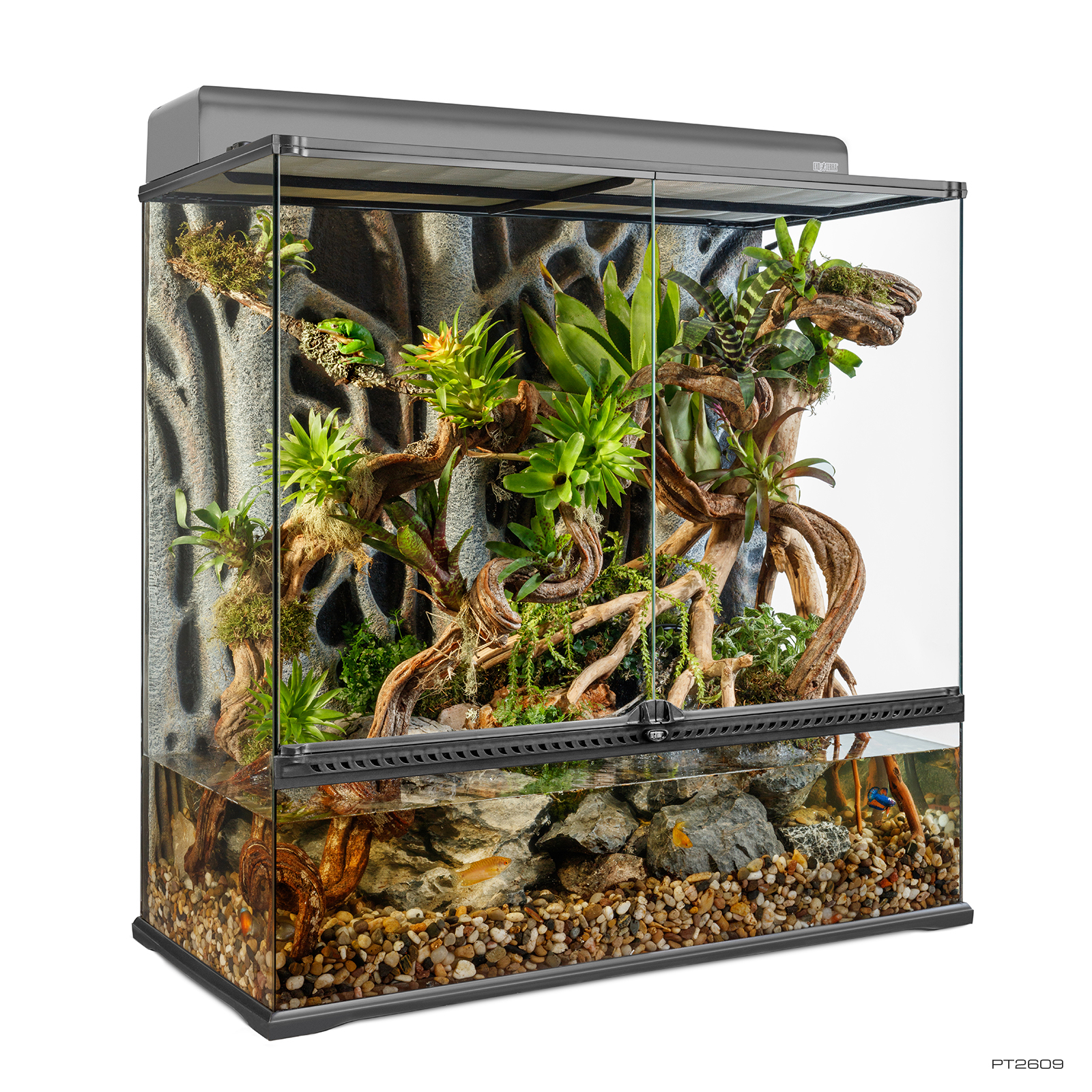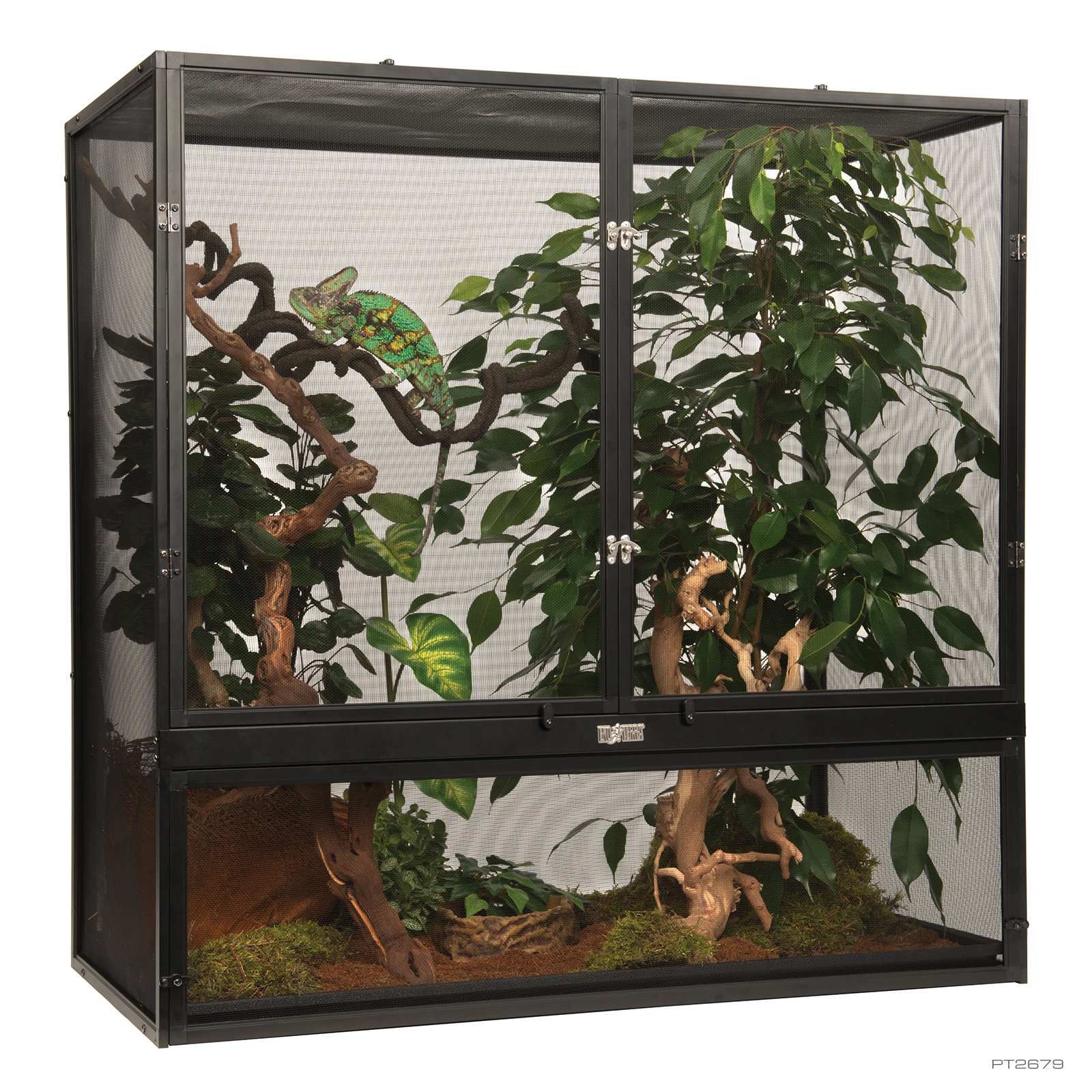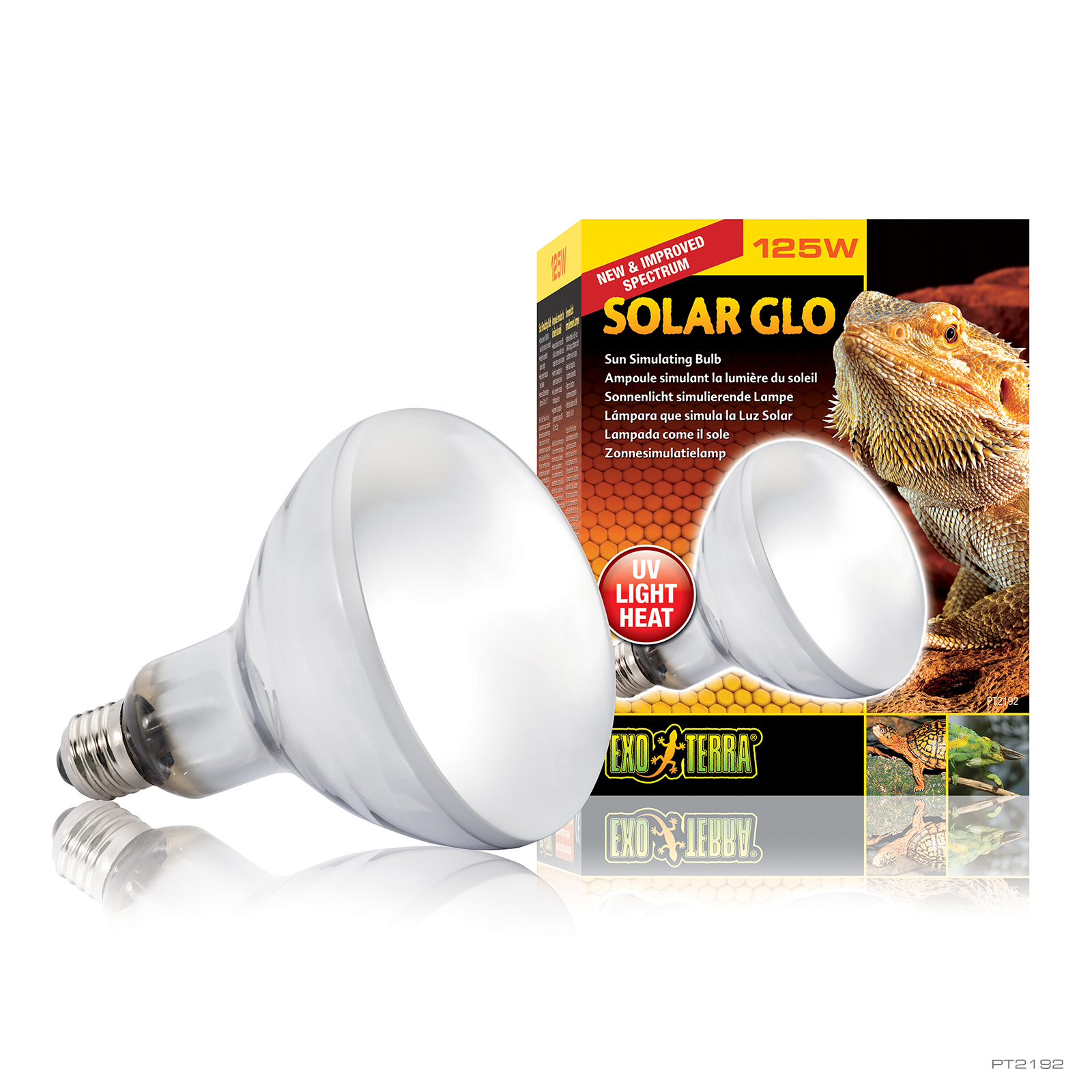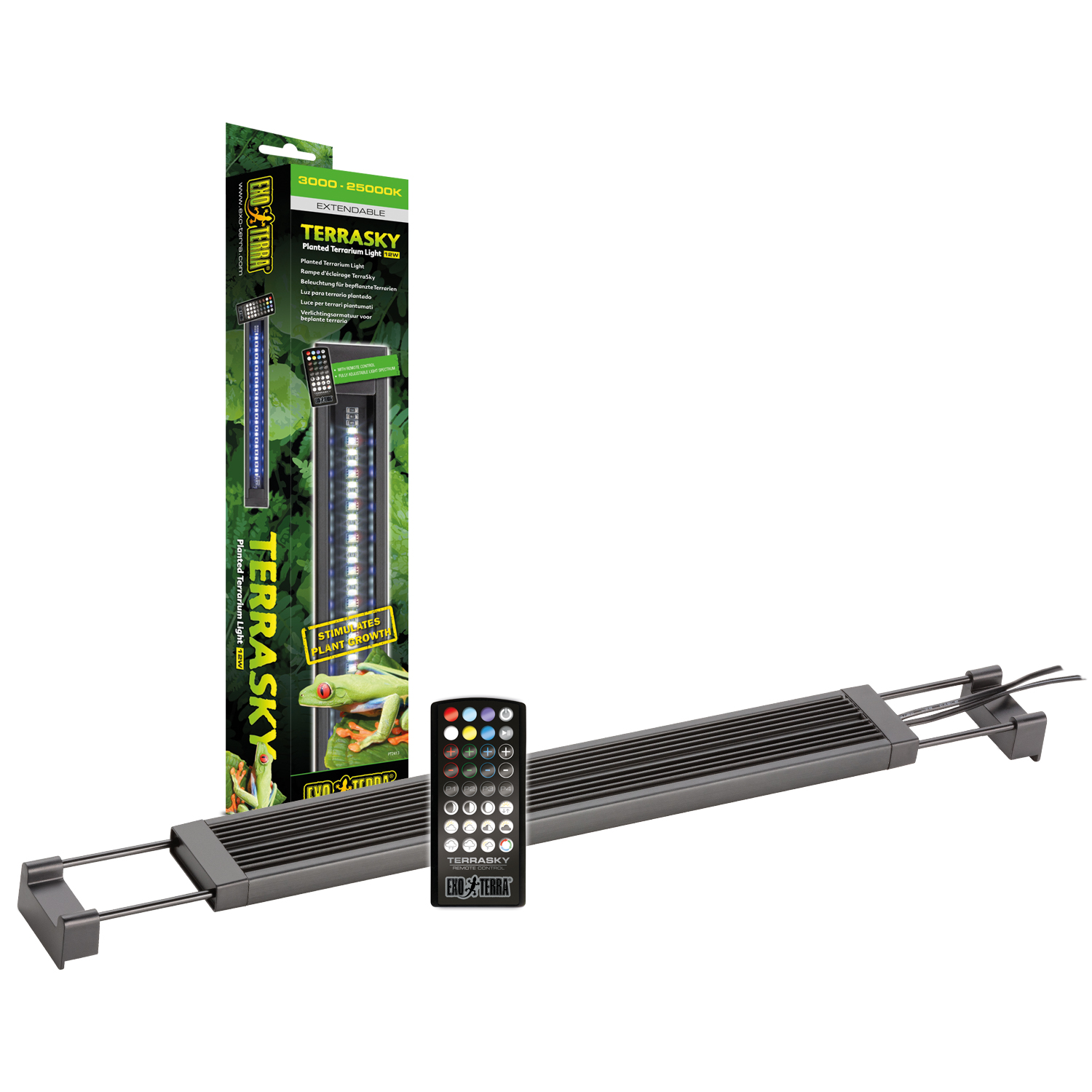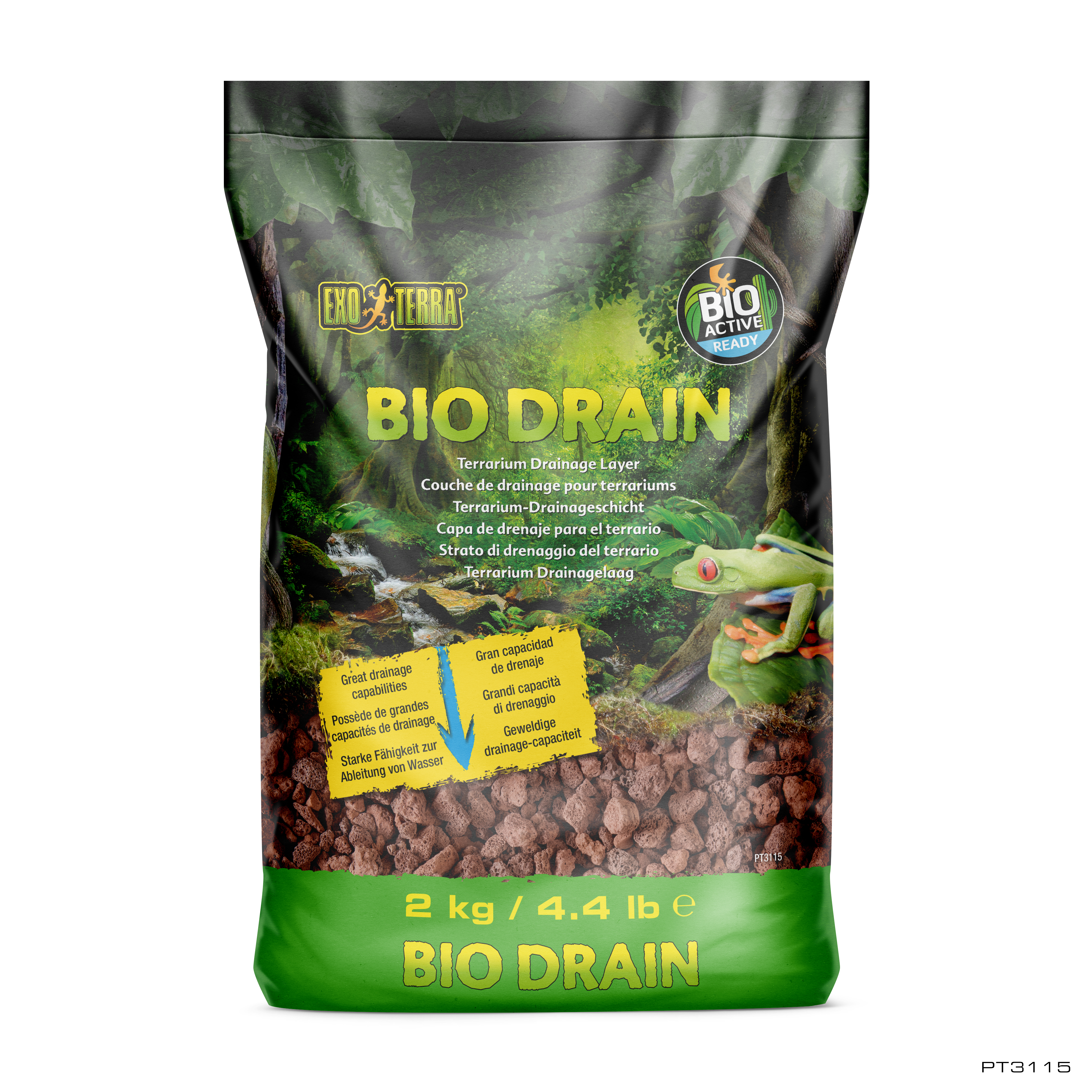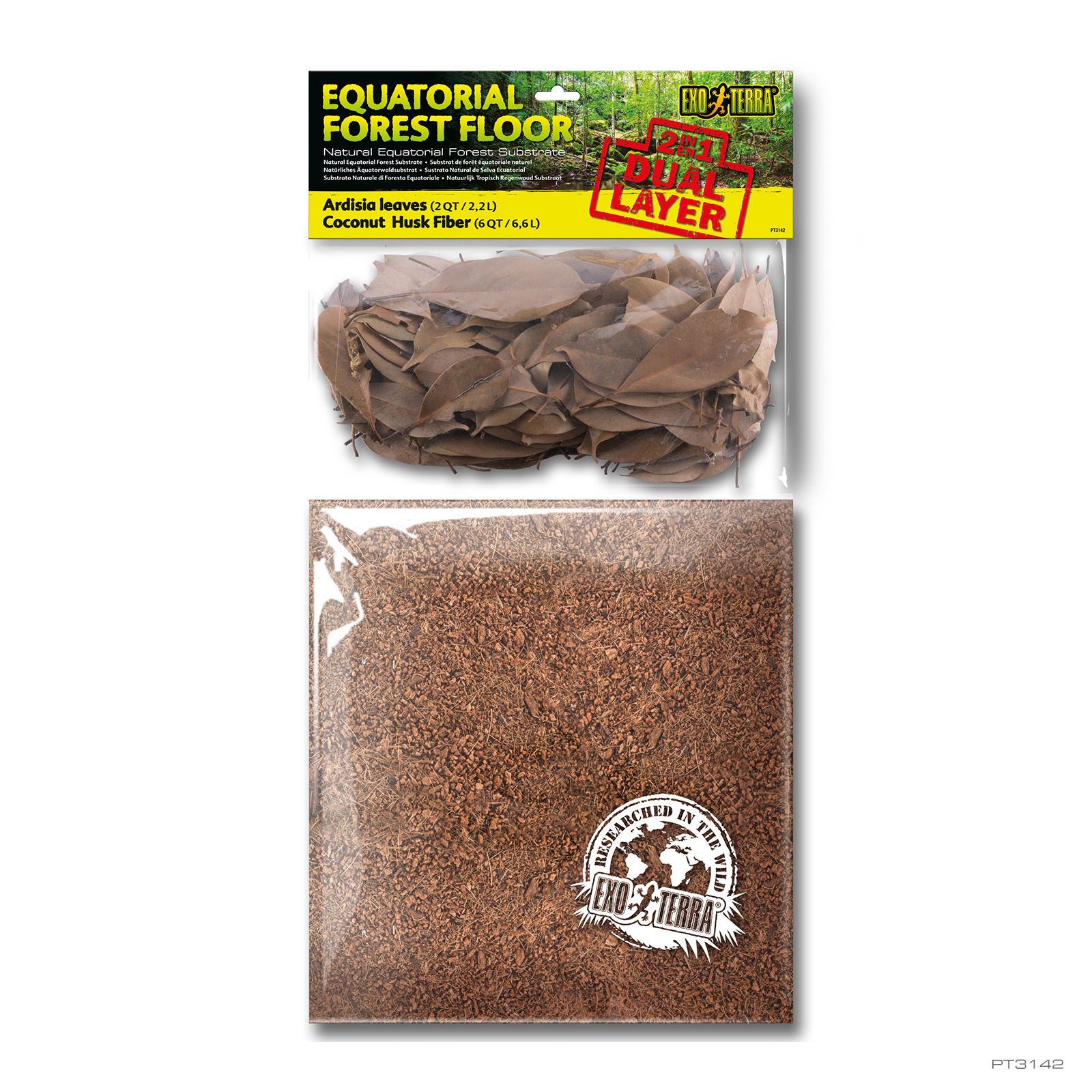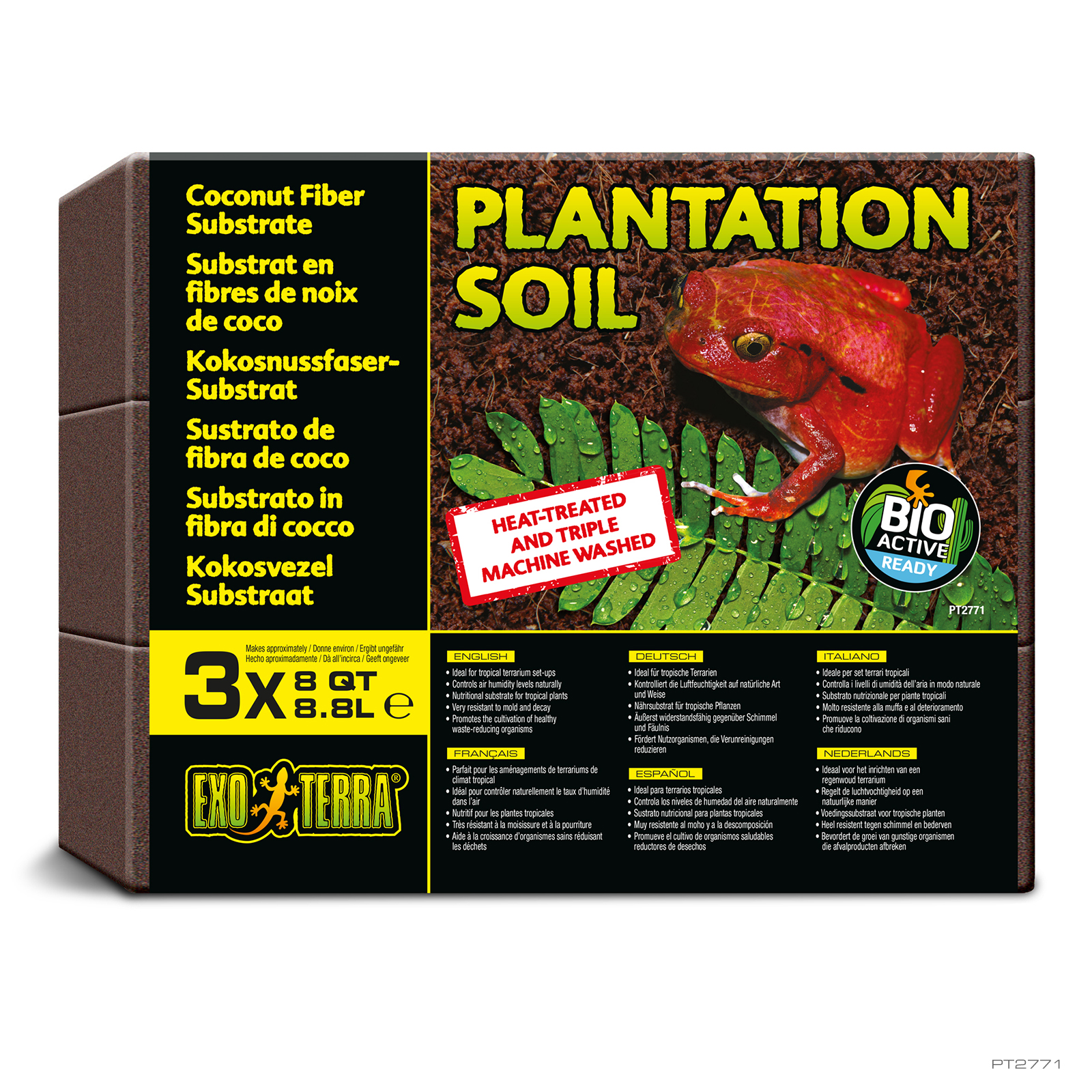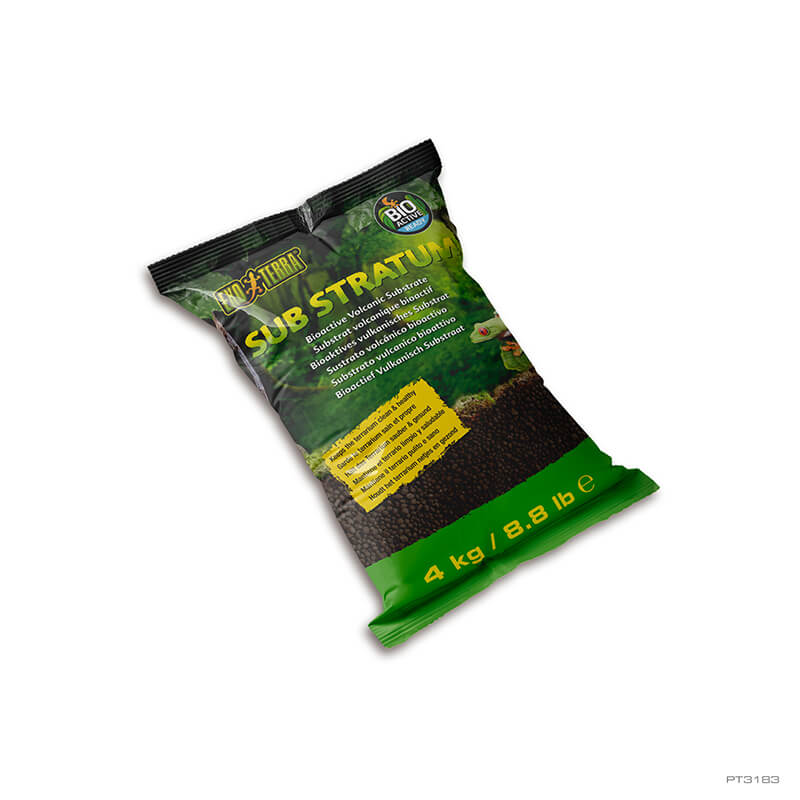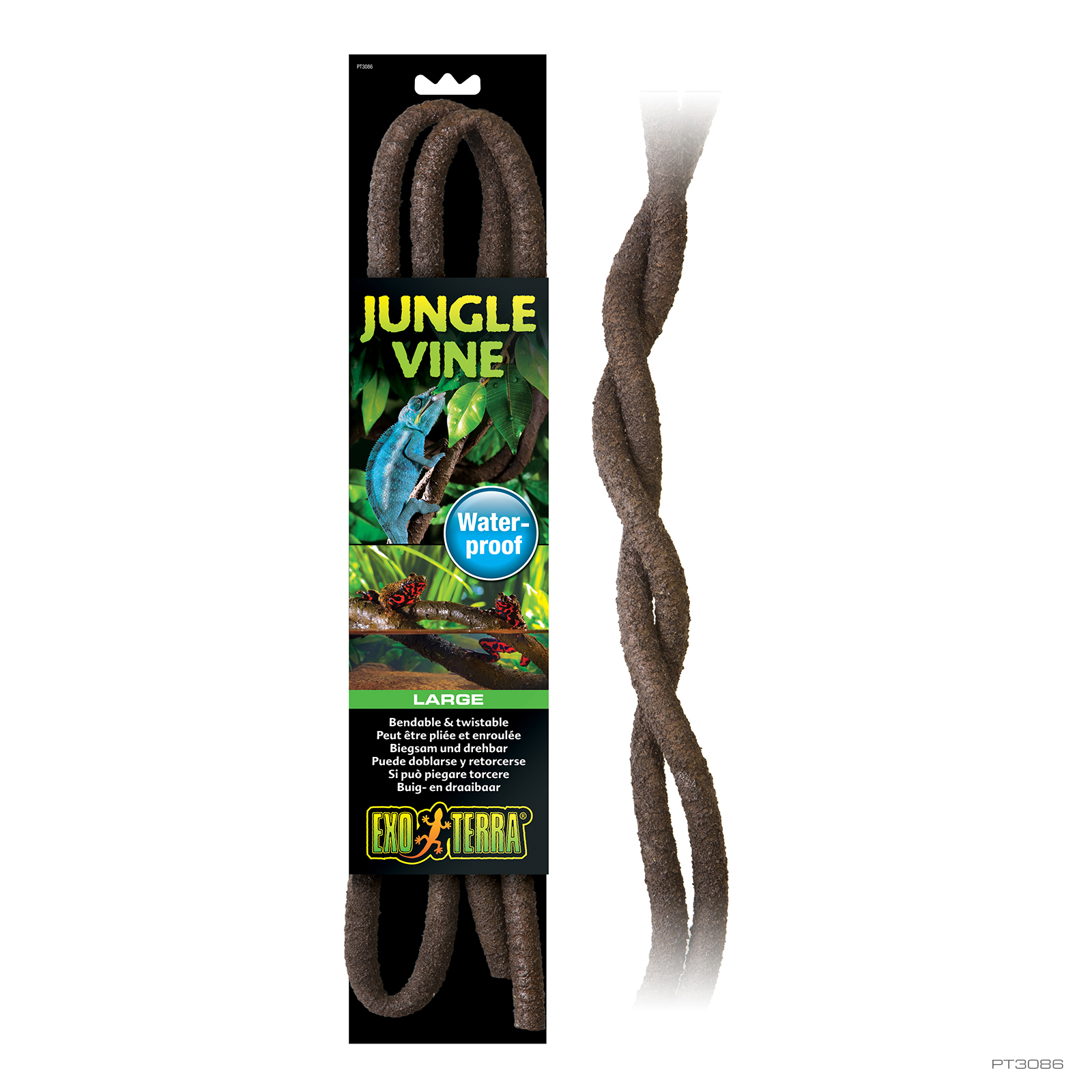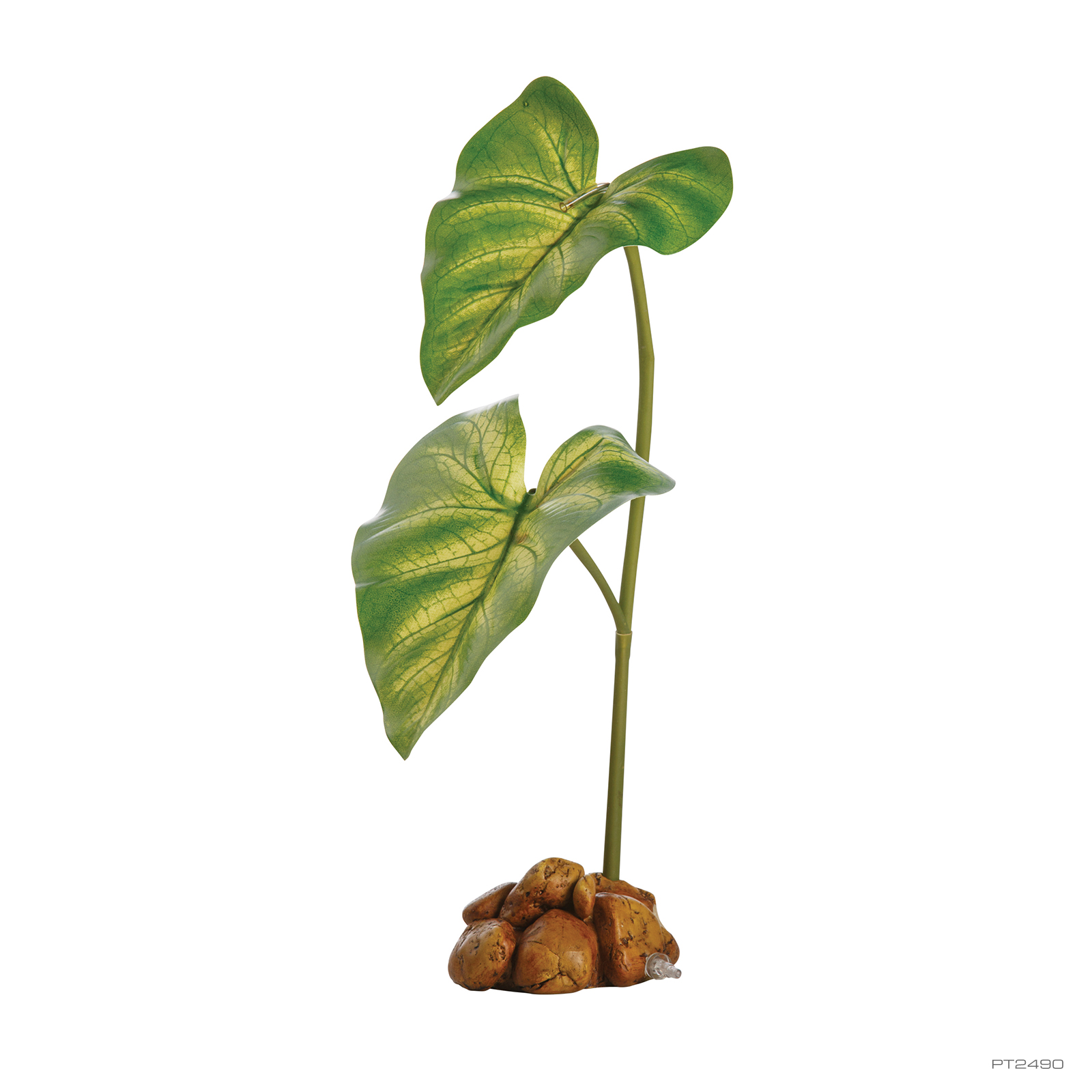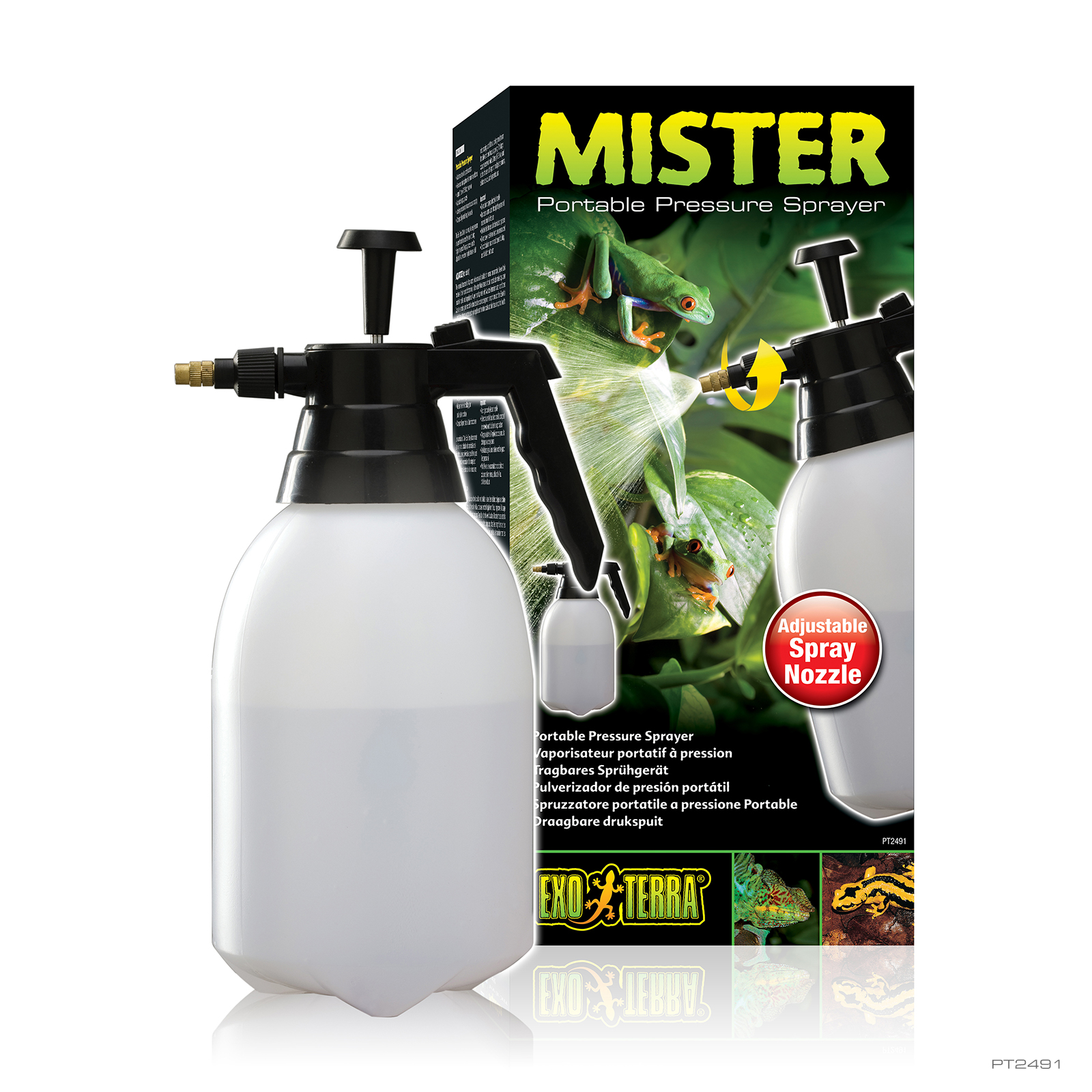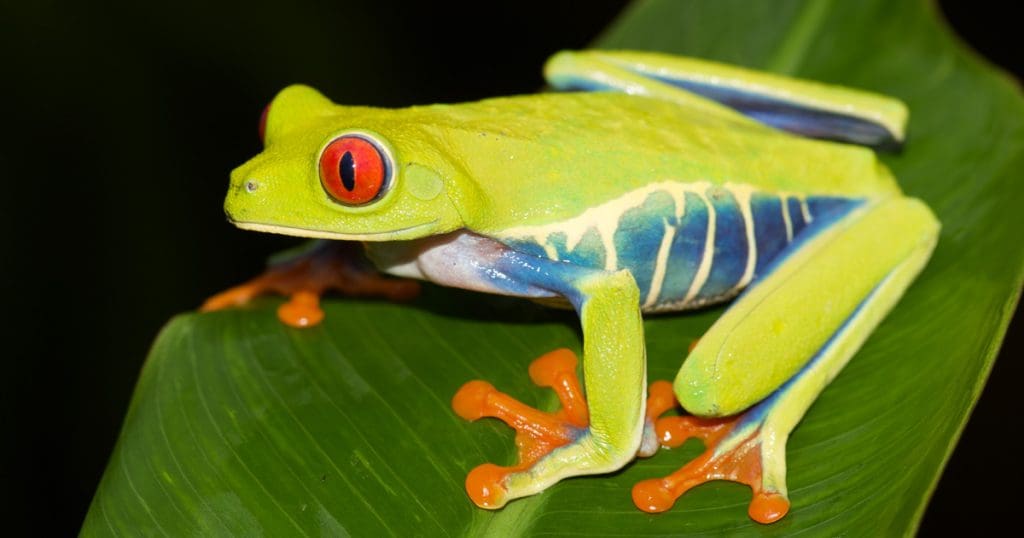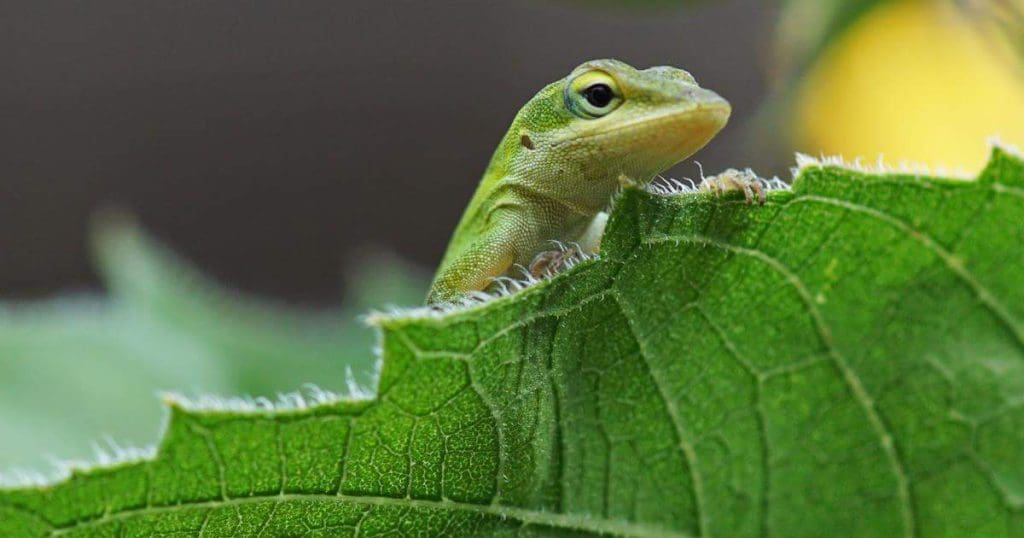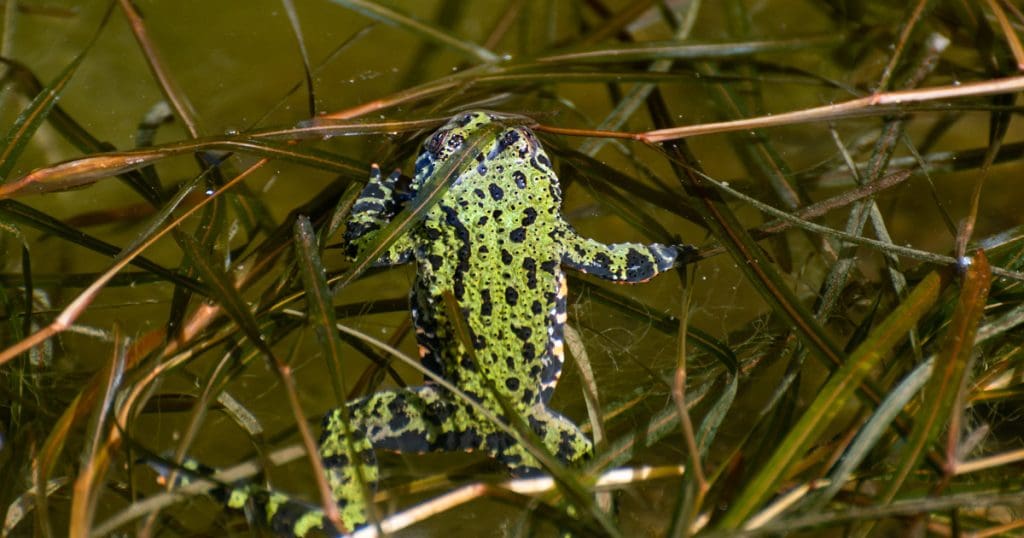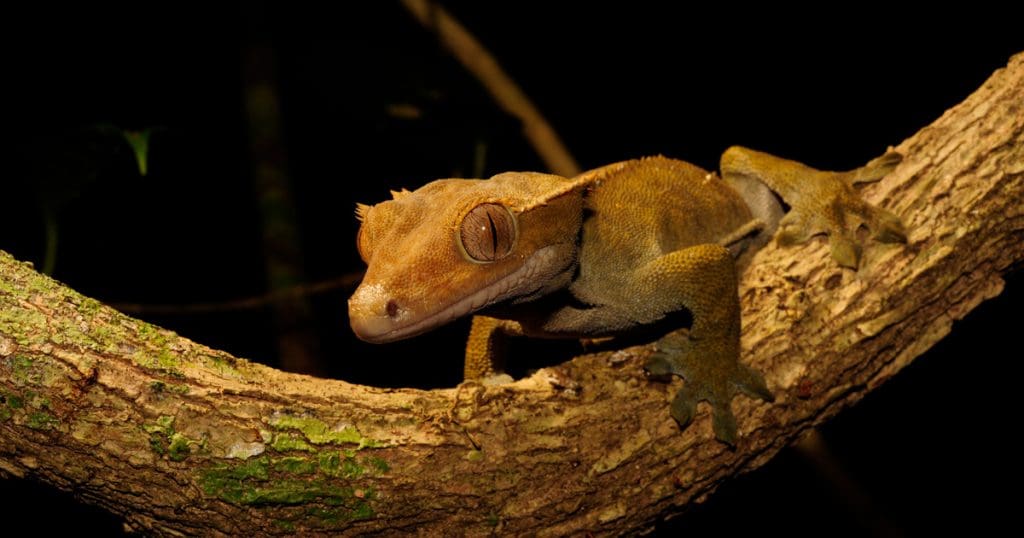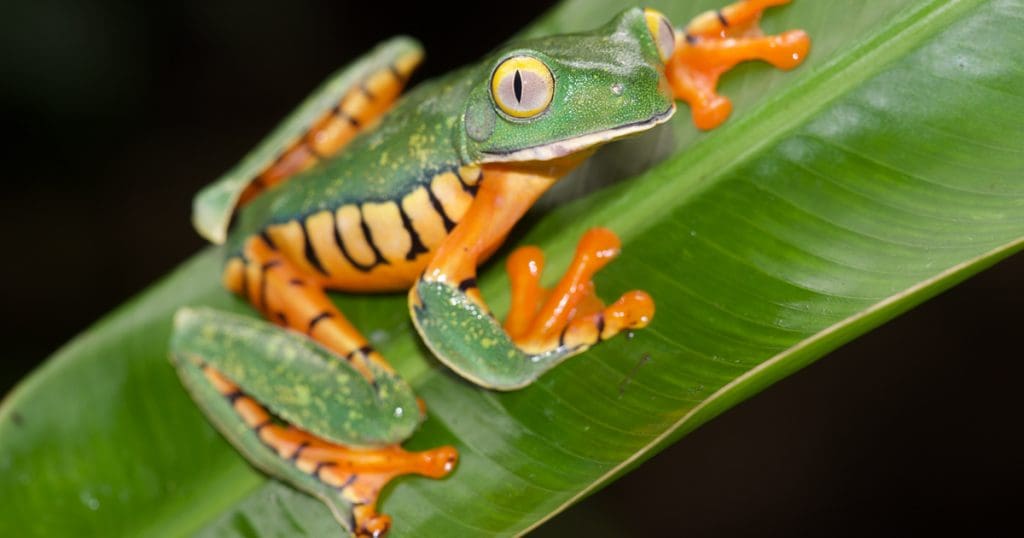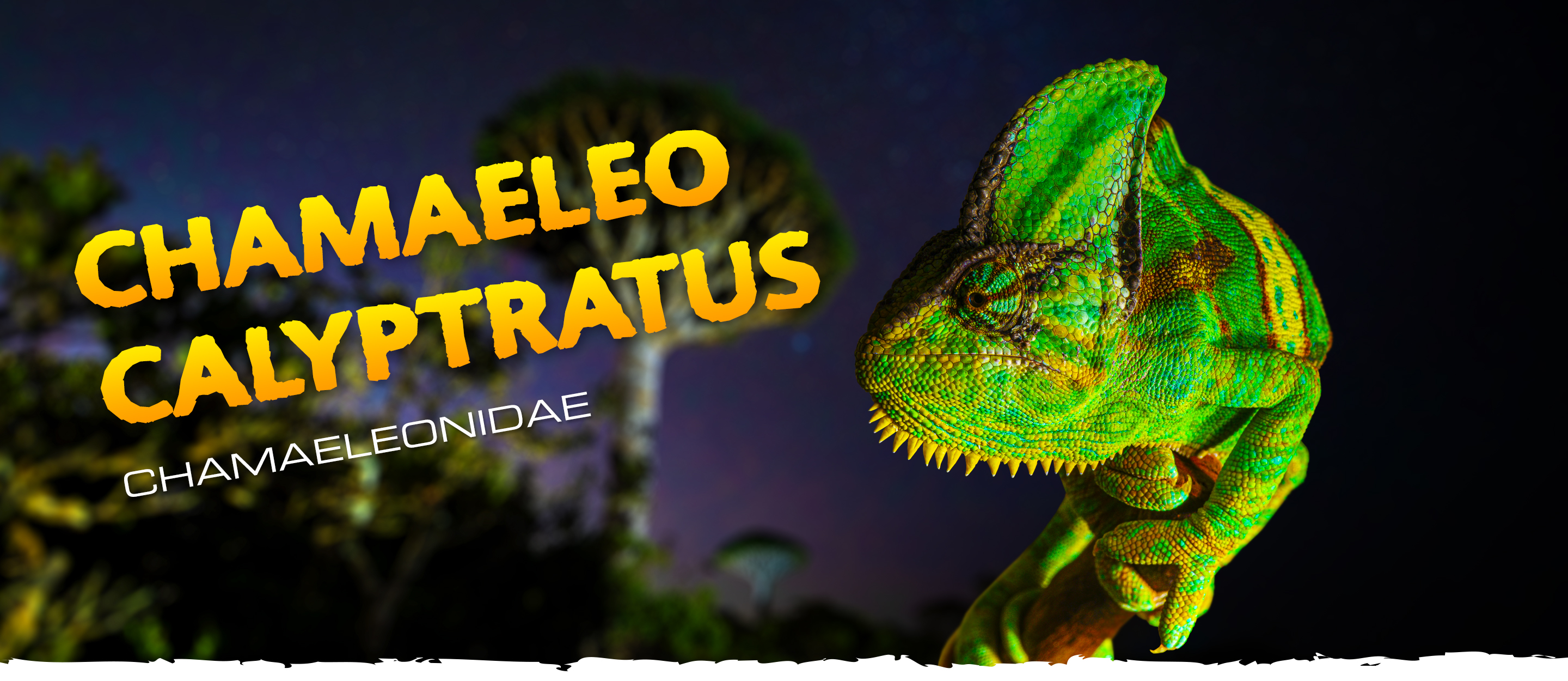
Chamaeleo calyptratus
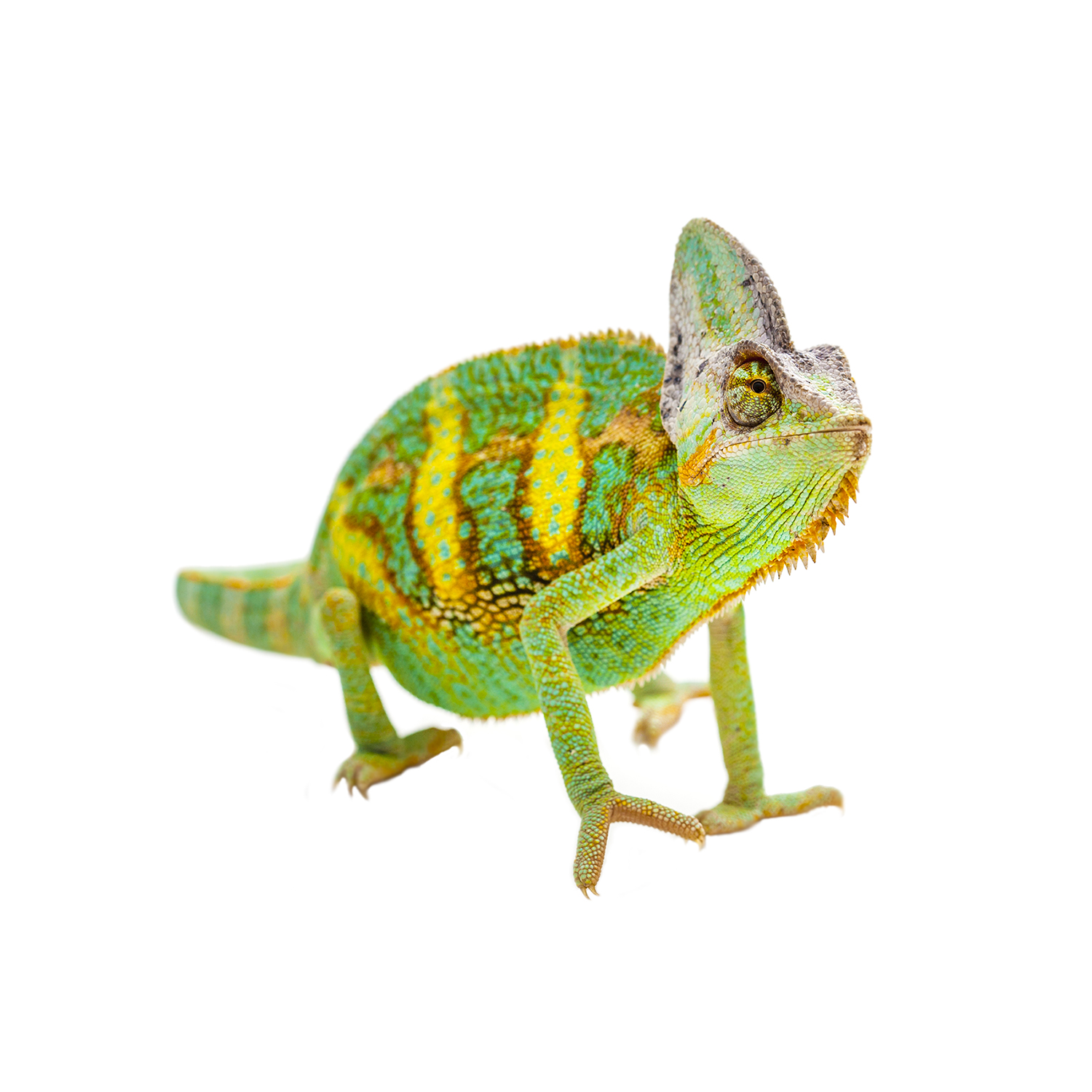

Veiled Chameleon
Veiled Chameleons or Yemen Chameleons are native to Yemen and Saudi Arabia. There are also introduced populations in Hawaii (thought to be eradicated but still persisting), California and SE and SW Florida, USA. They primarily prefer montane subtropical to tropical vegetation in the deep valleys (called wadis), in the Hijaz Mountains in Saudi Arabia and Yemen.
Since Yemen is suffering for over a decade of war and is not an easy country to travel to, or to export animals from, it is amazing how this species was established so well in the hobby. One of the first to study this species in nature, as well as establish the captive husbandry guidelines, was the world-renowned herpetologist Petr Necas. He bred tens of thousands of Veiled Chameleons and introduced these to the hobbyists in Europe and the USA. In the meantime, this species has become not only the most readily available chameleon, but also one of the more popular reptile species in general. Due to selective breeding, there are "bloodline" variations of the Veiled Chameleon available that show more yellow/orange or bluer and there's even a partially leucistic color morph available (called translucent in the USA).

History
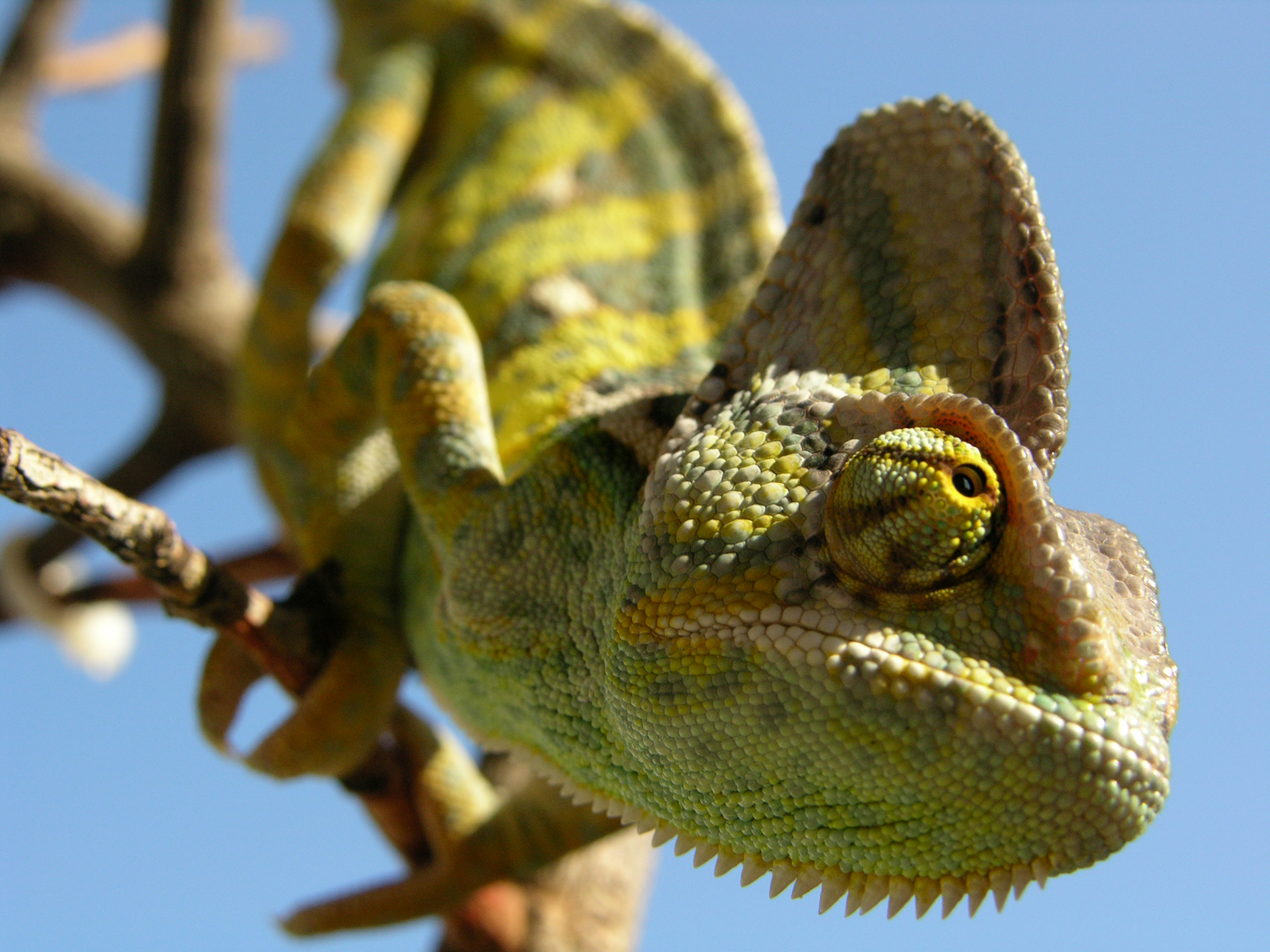
The French Zoologists André M. C. Duméril & Gabriel Bibron published their description of Chamaeleo calyptratus in André and his son Auguste Duméril's Catalogue méthodique de la collection des Reptiles.
The traditional belief is that the latin name Chamaeleon is derived from a composition of two Greek words, namely "chamai" or "crawling on the ground" and "leon" or "lion". Chameleon thus could be roughly translated as "ground lion" or "ground crawling lion", but according to the latest investigations, “hidden beast” is supposedly the more correct translation.
The common name Veiled Chameleon derives from the specific epithet "calyptratus", which means "hooded" or "under a hood" in Greek, referring imprecisely to the high casque of the males, and is used predominantly in the USA. This species is also referred to in many languages (more precisely) as Yemen Chameleon, pointing out that the Chamaeleo calyptratus is native to Yemen.
For a short period of time, Yemen exported a limited number of Veiled Chameleons. Fortunately, the herpetocultural pioneer Petr Necas, and many of his befriended breeders in the Czech and Slovak Republics had established a breeding colony of Veiled (Yemen) Chameleons and exported them all over Europe and the USA. Nowadays, Veiled Chameleons are literally available all over the world including Russia, China, Malaysia, Indonesia, Philippines, Thailand and even New Zealand.
Due to the hardiness and willingness to breed, the Veiled Chameleon, rapidly became the most commonly kept and bred species of the genus Chamaeleo. Veiled Chameleons have now been captive bred in Europe and the USA for more than 30 years.
Characteristics
Veiled (Yemen) Chameleons belong to the family Chamaeleonidae, Genus Chamaeleo.
Veiled Chameleons have the typical chameleon characteristics such as the vertically flattened body, the prehensile tail, the pincer-like grasping feet, the independently movable eyes, the extremely long projecting tongue and of course the possibility to change color.
Chameleons can expand their body to show a more rounded body shape or compress it to become rather flattened. This helps them to navigate through the vegetation, but the main purpose of this ability is a means of communication. By flattening their body and showing it sideways to the opponent, they try to look larger and fiercer. This can be used to scare off a predator, but also to impress another male entering the territory. This feature is also used for thermoregulation, as through flattening, they expose a wider area of the body to sun rays.
Chameleons are perfectly adapted to their arboreal lifestyle. Their prehensile tail helps them balance while walking on the tin branches of the vegetation that they live on. The tail can also be used to hold onto a branch, while at the same time they firmly grasp the branch with their pincer-like grasping feet. The Chameleon's front feet have 2 merged digits on the outside and 3 on the inside, while on their hind feet it is vice versa. This specific composition of their digits was recently named chameleodactyly. Their grasping feet, with claws on each digit, assure a firm grip while climbing branches, even when there's very heavy winds.
The Chameleon's eyes are an extraordinary technical feature created by Mother Nature. The eyes are completely covered by a muscular eyelid except for a pinhole opening that exposes the pupil. Due to the unique anatomy of the eyes, they're able to rotate the eyes in an almost 180° angle independently from each other, focusing on 2 totally different directions, providing the Chameleon with a nearly 360° view. The Chameleon can switch between monocular vision to binocular vision whenever needed. When 1 eye notices a prey insect, the Chameleon immediately uses his second eye to switch to binocular view in order to increase the depth perception. With this binocular vision, the Chameleon can estimate the exact distance to the prey insect, and here comes another piece of Mother Nature's ingenuity into play, the Chameleon's projectile tongue.
The Chameleon's tongue is actually kind of a tubular muscle that is retracted over the hyoid horn while at rest. Three major contributors make the tongue mechanics work: the retractor muscle has a dual function and keeps the tongue in place over the hyoid horn while in rest, but also retracts the tongue once the prey insect has been caught. The accelerator muscle is responsible for projecting the tongue at an enormous speed towards the insect, fast enough to catch a fly in midair. And last but not least, the sticky tongue's viscous adhesive property is strong enough to pick up prey insects with a weight of up to 30% of the Chameleon's own body mass. The viscosity of the mucus on the Chameleon tongue is about 1000 times stickier than human mucus (Prof. Pascal Damman of the University of Mons, Belgium). According to Dr. Schwenk of the University of Connecticut, there's also a lingual suction cup effect at play, which strengthens the grip on the prey insect when the prey is dangling while the tongue is 'reeled' back into the mouth.
Ever since Aristotle himself, the forefather of Western philosophy and keen zoologist, described the color change in Chameleons in his Historia Animalium in 350 BC, people have been fascinated by the Chameleon's ability to rapidly change color.
The Chameleon's skin contains various layers that all contribute to the color changing ability.
The color changes are a combined effort of the melanin filled black color Chromatophores, the Melanophores, and the Iridophores containing crystals of Guanine. While the Melanophores provide dark and light shades of the body from white to black, the Iridophore Chromatophores are responsible for most of the color adjustment by determining the reflection of light. Iridiphores contain tiny guanine crystals which adjust the way they reflect light depending upon the spacing between the individual nanocrystals and using the two independently above each layer of guanine. By relaxing or stretching the Chameleons skin, the distance between the nanocrystals varies and changes the reflection of the light which is then perceived as a color. The color blue for instance, is formed when the skin is in a relaxed state because the nanocrystals are very close to each other, and they reflect short wavelength light. However, when this blue color passes the yellow color reflected by the upper layer, humans will perceive the Chameleon's color as green. When the skin becomes excited, for instance when meeting a rival male, or a potential mating partner, the distance between neighbouring nanocrystals increases, reflecting longer wavelength light forming yellow, orange or red color (Prof. Michel Milinkovitch of the University of Geneva, Switzerland). The color changes are not primarily meant for camouflage, but rather as a means of communication during social interactions. The changes also aid in thermoregulation and signal the health and physiological state of the animals.
The base color of the Veiled or Yemen Chameleon varies in different shades of green with turquoise, yellow and black accents. Males typically show three yellow vertical bands on the flanks, while only females show orange dots on the flanks, but no yellow bands. The coloration of the females also has a "built-in pregnancy test", since their color changes depending upon their reproductive cycles. Once a female is pregnant, her uniform green base-color will also show orange spots and dots. When a male approaches a pregnant female, the female's green-base color changes into black with very outspoken orange and turquoise spots and dots. Hatchlings on the other hand show a uniform pastel green color with some darker pattern and will only develop the other colors and patterns when they mature.
Veiled Chameleons have another very specific characteristic, namely their up to 8cm high cranial casque, or helmet-like structure. This is especially evident in male Chameleons, as females show much smaller casques. The casque also shows small and thin occipital lobes.
The size difference between Veiled Chameleon males and females is significant. Males can grow up to 60cm or 2ft, while females only reach 30cm or 12" on average, but usually stay a lot smaller.
Veiled Chameleons can reach sexual maturity at an incredible young age of 4 months. Their rapid growth is determined by the specific climate of their home country. As the ability to mate and develop and deliver eggs is dependent mainly on size, we recommend you to wait until males are around 1ft or 35cm and females around 9" or 25cm long, including tail. This will ensure that the animals are physically strong enough to handle the arduous process of egg development and egg laying.
Apart from the size of the casque, different coloration and hemipenal bulge at the base of their tails, sexing Veiled Chameleons can be pretty easy from the moment they hatch. Long before any other sexual differences become visible, the tarsal spur, which is absent in females, can be distinguished on the Veiled Chameleon male's hind feet from birth.
Distribution
The Veiled Chameleon is most common in the long and deep valleys, called Wadis, formed by the Hijaz Mountain range, situated from the Asir region in Saudi Arabia up to the Taizz region in Yemen. Veiled Chameleons have also been introduced to Hawaii (Kraus & Duvall 2004), where a drastic eradication program was almost successful. In Florida (Krysko et al. 2011) they have established solid breeding populations, and this already for the second decade. Recently, the evidence of their invasion to California has been delivered too.
In the Wild
Veiled Chameleon are diurnal reptiles with a mostly arboreal lifestyle. Chameleons are perfectly adapted to their arboreal lifestyle. Their prehensile tail and chameleodactylous feet assure that they can forage in the vegetation without the risk of falling. Veiled Chameleons do not have a specific habitat, and Petr Necas located specimen in acacia trees, euphorbia, various shrubs, corn fields and even found them on the ground. Veiled Chameleons are known to spend time close to the ground between plant roots or even in empty burrows and rock crevices to protect themselves against de cold during wintertime, which is also the dry season in Yemen.
There are 2 very distinct seasons in the Veiled Chameleons environment, the rainy season and the dry season. The rainy season starts at the end of April and lasts up to September. The rainy season means paradise for Veiled Chameleons, this is the time of the year where everything happens. The temperatures increase to 26-28°C or 80-82°F during the day and 18-20°C or 65-68°F at night. The daytime humidity ranges between 30% and 60% depending on rain, but raise to 100% on foggy nights. Due to heavy rainfall, the vegetation grows lushly and the overall humidity increases. Prey insects are to be found in abundance. This is when the young chameleons hatch and start to grow rapidly, so already two months before the end of the rainy season, they're ready to mate and produce viable eggs, for the next generation. Starting October, the dry season brings lower temperatures dropping to 22°C or 72°F during daytime in December and January, and a low 8-10°C or 46-50°F at night. The humidity is extremely low during daytime, dropping even under 20%, but at night, the humidity rises thanks to the deep temperature drop to level over 80%, with regular nighttime fog even in the driest periods of the year.
In the valleys or Wadis where the Veiled Chameleon lives, for instance in Tihama, the environment is tropical with warm temperatures and lush vegetation. In these Wadis, there are dry riverbeds that always have water, either visible as a creek or river, or mostly underneath the surface. This nice tropical environment, however, only lasts as long as the rainy season, starting in April and ending in September. During the dry season, the climate completely changes with lower average temperatures during the day and extremely cold during the night. Humidity gets as low as under 20% and even the acacia trees lose their leaves. At night, the humidity will still reach about 100%. Unfortunately, many Veiled Chameleons in the wild die during the dry season due to predation. Before human settlement, they made use of the dry leaf layer to hide and stayed hibernating for several months. However, due to heavy environmental pressure from humans for thousands of years, there is no leaf layer remaining. The big, exposed animals die usually through predation by birds of prey, crows, marsupials and even rats.
During the rainy season, Veiled Chameleons have the following activity patterns during daytime. In the early morning hours, they bask on the outer branches of the vegetation for about 20-30 minutes, then they withdraw into the shade and start hunting for food, socialize with their kin, until in the late afternoon around 16:00-17:00 (4 - 5 PM) when they move out in the open and bask again for about half an hour to 1 hour. Exception to the rule are the dominant males, who are always on the lookout for competitive males entering their territory. Once the male sees an opponent, he will flatten his body, making himself as large as possible and flare off the brightest color, to scare away the intruder.
During the dry season, Veiled Chameleons are only somewhat active between 8:00 and 17:00, the rest of the day they're asleep or hibernating.

In the Terrarium
Veiled Chameleons are diurnal reptiles with a primarily arboreal lifestyle and will only descend to the ground for feeding, egg-laying and under certain conditions to find hide-outs. For this reason, they require tall terrariums to accommodate plants and climbing structures. Taller terrariums will also allow for more stratification to enrich the environment and create a visually more appealing display.
Veiled Chameleons are solitary creatures, and we recommend housing them individually, except for brief breeding introductions. Male Veiled Chameleons are highly territorial and aggressive towards other males, but will also cause stress to females due to their relentless mating behavior. Females are more tolerant of one another if kept in large enough enclosures, but even then, territorial behaviour might occur, especially if one of the females becomes pregnant.

Terrarium
Veiled Chameleons thrive best in vertically oriented, well-ventilated terrariums like the Exo Terra® Natural Terrariums and the Exo Terra® Screen Terrariums, as stagnant air and permanent high humidity are detrimental to the Veiled Chameleon's health.
Exo Terra® Natural Terrariums, designed by European herpetologists, are the ideal arboreal enclosures for Veiled Chameleons. These glass terrariums feature front opening doors, allowing easy access for maintenance and feeding and a unique double ventilation system with full screen stainless steel top. The full screen stainless steel top allows ultraviolet rays from UVB lights to penetrate deep inside the enclosure. The dual ventilation system allows sufficient airflow during the day, while it facilitates to keep the relative humidity at an optimal level during the night. In the back of the screen cover are 5 closable wire or tube inlets on both sides to facilitate the installation of powered accessories like waterfall pumps, filters, Exo Terra's Monsoon, etc.
The Exo Terra® Screen Terrarium is a perfect habitat for arboreal reptiles that are sensitive to stagnant air. The non-restricted airflow provides optimal ventilation while minimizing odors and fungus growth in your reptile’s habitat. The screen design provides a broader temperature gradient, which helps your Veiled Chameleons to regulate their body temperature more effectively and prevents overheating. The aluminum screen mesh allows ultraviolet rays from UVB lights or the sun to penetrate deep inside the enclosure. The substrate tray allows you to place a small layer of substrate to absorb spray water and increase humidity levels. The substrate tray can easily be removed from the enclosure through the swiveling bottom door. The sturdy latches add stability to the enclosure and keep your Veiled Chameleons safe & secure.
The set-up can be a simple “sterile-type set-up" with an Exo Terra® Moss Mat, a Dripper Plant with a Water Dish, a potted live plant in combination with some Exo Terra® hanging plants, and some branches and Exo Terra® Vines as climbing space. Or you can offer your Veiled Chameleon a more natural, “bio-active type set-up” by replacing the Exo Terra® Moss Mat with a Tropical Forest floor created by a bottom layer of Sub Stratum, a middle layer of Plantation Soil, topped with Ardisia leaves (Equatorial Forest Floor).
Never house 2 male Veiled Chameleons together in one terrarium as they tend to be very territorial.
DISCLAIMER In regards to the pet species and number of specimens to be kept in a terrarium, always comply with the species specific Rules and Regulations in your Country of residence.
DISCLAIMER The terrarium should be placed in a room receiving only indirect light from windows. Do not place the Terrarium near a window where it can receive direct sunlight, as this could cause the terrarium to overheat and stress or kill your Veiled Chameleon.
Lighting
Veiled Chameleons are diurnal, meaning they’re active during daylight. Since Veiled Chameleons are heliophilic, meaning they are attracted to sunlight, we have to provide them with a combination of sufficient visual light, UVA, UVB and Heat rays during daytime.
A 12-hour day/night cycle is an adequate photoperiod for the healthy all-year-round keeping of your Veiled Chameleons. The more natural approach, and to induce breeding, is to provide higher temperatures with 13 hours of daylight and 11 hours of nighttime during the rainy season, and reduce the daylight cycle to 11 hours daylight and 13 hours nighttime during the dry season.
The lighting for Veiled Chameleons consists of 2 parts. A very important role for the illumination of heliophilic Chameleons is reserved for the visible light in combination with UV radiation. The other part of the "lighting" is actually a combination of "light & heat" in the form of incandescent bulbs. Chameleons do not recognise non-visible heat sources like ceramic heat emitters, heat cables, heat mats, etc.
Proper UVB Lighting is VITAL for your Veiled Chameleons! It is very important that the upper ⅓ of the terrarium is reserved for proper basking spaces at different levels, so the Chameleon can actively thermoregulate and UV-regulate by targeted basking. The correct UVB wavelength assures that provitamin D3 (7-Dehydrocholesterol) can be converted into pre-Vitamin D3. Once this is formed, the heat rays will then provide the correct temperature for the thermal isomerisation into actual Vitamin D3. Without the combination of light, heat and UVB, your Veiled Chameleon cannot produce the necessary Vitamin D3 to absorb calcium from their food. A major dietary problem in captive reptiles is the low assimilation of calcium from their daily food. Calcium is vital for bone growth and maintenance, muscle function, and many of the body’s most important metabolic functions.
There are various solutions to offer your Veiled Chameleons quality lighting. You can either go for all-in-one bulbs like the Exo Terra® Solar Glo or Solar Ray, which provide optimal levels of UVA, UVB, visual light and heat all in one bulb! These bulbs deliver a consistent spectrum, which closely approximates that of natural sunlight, contributing to the animal’s overall wellbeing. The combination of the correct UVB wavelength and heat enables the animal to produce its own vitamin D3 for proper calcium absorption and prevents metabolic diseases (e.g., MBD). The powerful light output and balanced UV rays stimulate appetite and breeding behavior, while improving the physiological health of reptiles.
Or you can choose for a combination of fluorescent UVB lighting (like the Reptile UVB150/200 linear or Reptile UVB150/200 compact) in combination with an incandescent heat bulb (like the Exo Terra® Intense Basking Spot or Halogen Basking Spot).
In order to increase the overall visible light, the Exo Terra® TerraSky Planted Terrarium Light is the ideal LED lighting solution for planted setups and bioactive terrariums. The high intensity and enhanced penetration ensure that the light reaches all layers of the terrarium, resulting in sustained lush plant growth. Orchids, Bromeliads, Tillandsias (air plants), carnivorous plants, mosses and lichen all thrive under the TerraSky Planted Terrarium Light’s strong Photosynthetic Active Radiation (PAR). The 120-degree light dispersion provides a nice even illumination and covers the complete area to avoid dark spots.
Heating
Monitoring
Veiled Chameleons require a specific temperature range both during nighttime and daytime to thrive (see “Heating”). They also do best at a moderate relative humidity of around 50% during daytime and over 90% at night.
Use the Exo Terra® Digital or Analog Thermometers and Hygrometers to help you monitor the terrarium conditions and adjust the temperature and relative humidity to meet the needs of the animals. It is best to always use 2 Thermometers, one placed at the coolest end of the terrarium and the other one placed at the warmer end.
For more security and peace of mind, the Exo Terra® Thermostats or Thermostat & Hygrostat will help to prevent overheating and undercooling during hot summer days or cold winter nights. Apart from the temperature, the Exo Terra® Thermostat & Hygrostat will also help keep the humidity at the desired level. With the Exo Terra® Thermostats or Thermostat & Hygrostat you can create a well-controlled heating/humidifying system that allows you to maintain the required temperature and/or humidity conditions similar to those found in your animal's environment.
Substrates
Chameleons are primarily arboreal and don't bother too much about the kind of substrate used in their housing, except when females need to lay their eggs or when temperature and humidity conditions become unbearable.
The set-up can be a simple “sterile-type set-up" with an Exo Terra® Moss Mat, a Dripper Plant with a Water Dish, a potted live plant in combination with some Exo Terra® hanging plants, and some branches and Exo Terra® Vines as climbing space. Or you can offer your Veiled Chameleon a more natural, “bio-active type set-up” by replacing the Exo Terra® Moss Mat with a Tropical Forest floor created by a bottom layer of Sub Stratum, a middle layer of Plantation Soil, topped with Ardisia leaves (Equatorial Forest Floor).
1. “sterile-type set-up” The Exo Terra® Moss Mat is a convenient substrate choice especially for hatchling and young but also for adult Veiled Chameleons. The Exo Terra Moss Mat is an extremely natural-looking terrarium substrate. Soft, hygienic and absorbent the Exo Terra Moss Mat is easy to use and can be cut to fit any terrarium size. It allows you to perfectly spot-clean the bottom part of the Chameleon's terrarium for maximum hygiene. Simply rinse clean when soiled or replace as necessary.
2. “bio-active type set-up”
a. The substrate layer can consist of a single layer of Exo Terra® Sub Stratum, Exo Terra® Plantation Soil or a mixture of both, which will provide the benefits of both substrates.
The live bacteria in the Exo Terra® Sub Stratum will activate when the substrate comes in contact with water or waste. The organic matter such as left-over food and animal waste will decompose over time. The absorbing properties of volcanic ash will eliminate odours by trapping the decomposed materials. By mixing the Exo Terra® Plantation Soil with Exo Terra® Sub Stratum, you enrich the substrate with the required minerals like calcium, nitrogen, potassium and phosphorus. It also aids in the water retention capacity and provide adequate air supply to the roots.
b. For advanced drainage and aeration, you can use the multi-layered Bio Drain System. In the Bio Drain System, you use an inorganic bottom drainage layer, like Exo Terra® Bio Drain Substrate or Exo Terra® Sub Stratum, which you cover completely with the non-decomposable Bio Drain Mesh. This will allow proper water drainage and aeration of the substrate layers you will built up on top. The actual substrate layer that will be used for planting can consist of mixture of Exo Terra® Sub Stratum with Exo Terra® Plantation Soil. The multi-layered Bio Drain System with the Sub Stratum and Plantation Soil mix will allow proper drainage and aeration, preventing foul smells often associated with damp soils.
The Exo Terra® Sub Stratum is a natural volcanic soil with live beneficial bacteria. The porous surface and low-density structure allow for excellent drainage and aeration, but it also promotes a flourishing population of beneficial, nitrifying bacteria, creating a self-sustaining, living terrarium ecosystem. The active beneficial bacteria of the soil will decompose biological waste, keeping the terrarium clean and healthy.
The Exo Terra® Plantation Soil is a 100% natural, biodegradable terrarium substrate made from sustainable, ground coconut husk fiber grown on plantations in tropical Asia. The unique hygroscopic properties of this ecological substrate regulate the terrarium’s humidity in a natural way. The unique coir pith used for the Exo Terra® Plantation Soil consists of a mixture of short fibers and coco-peat grain sizes ranging from coarse granules to fine clumps resulting in improved soil drainage and aeration. The improved aeration of the substrate promotes the cultivation of healthy waste-reducing organisms keeping your terrarium fresh and clean.
The substrate should be kept slightly moist, but definitely not soaking wet, at all times. Make sure to offer different gradients of moisture inside the terrarium. Some parts can be kept rather moist while other parts should be kept somewhat drier. Young Veiled Chameleons prefer a somewhat more humid environment compared to adults. Also, try to vary the moisture depending on the season, spray more frequently during the warmer parts of the year. Preferably spray before the lights are switched on, and after they have been turned off.
The Exo Terra® substrates will help maintain the substrate moisture at an optimal level. Providing a top layer of Exo Terra® Leaf Litter or Forest Moss will also facilitate the substrate's moisture retention and prevent it from drying out. The Leaf Litter or Forest Moss will facilitate the natural ecosystem where beneficial organisms will break-down waste products and thus reduce odors.
The secret to growing healthy plants begins with the soil. Naturally, healthy soil contains living microorganisms — from bacteria to fungi, protozoa and arthropods. Together they form a choreographed exchange from the recycling of nutrients to the decomposition of organic materials.
Plants
Living an arboreal life in the subtropical acacia forests in Yemen, Veiled Chameleons spend all of their day, and even the nights, on branches and between the foliage of bushes and plants. This means plants in the terrarium, are not only important for decorative purposes, but they also allow you to recreate the micro habitat your Veiled Chameleons live in.
For Veiled Chameleons, plants have various purposes. The branches of the plants are used for climbing, while the dense foliage is used as a visual barrier, for thermoregulation, and the top leaves are used to drink dew droplets from in the morning. They even nibble the leaves of plants occasionally.
The Veiled Chameleon's zygodactylous feet are perfectly adapted to their all-day lifestyle of drinking, sunbathing, walking, eating, hiding, mating, sleeping, all while never leaving the branches of the shrubs they live in. In the terrarium, the branches of sturdy plants, represent the natural environment for your Chameleons. Next to the plant's branches, the terrarium should be decorated with additional branches that reach out above the dense foliage to serve as basking areas (see Decoration).
Chameleons are generally shy animals, which perform their complex social behavior over distance and don't like to be seen, unless they choose to. For this it is very important that the middle part of the Terrarium consists of dense foliage, as this will provide a visual barrier in which the Chameleon can retreat whenever it feels like. This is a very important factor, as it provides the Chameleon with a feeling of security and thus reduces stress. Once the Chameleon feels secure, it will show itself a lot more, knowing that it can retreat rapidly whenever it feels at risk.
This dense foliage will also provide a perfect microclimate within the Terrarium. The temperature will be lower than in the basking area above, while the humidity will be somewhat higher. This microclimate allows the Chameleon to thermoregulate its body temperature and regulate its exposure to UV by withdrawing itself from the basking area. While hiding from the heat and UV rays, the Chameleon can also replenish some moisture through their nostrils and respiratory tract.
Chameleons, and many other arboreal reptiles, generally do not recognise motionless bodies of water as a drinking source. In nature, they hydrate mainly through the exposure to fog at night and drink dew droplets that formed on the leaves in the morning, or rain drops that remained on the leaves after a short rain. These water drops are recognised by the Chameleons as a drinking source. Spraying or misting the terrarium plants in the morning and evening will provide water droplets for your Chameleon to drink. Exo Terra® designed a plant for this specific drinking behaviour, the Exo Terra® Dripper Plant (see Watering).
Adding a mix of decorative live and Exo Terra® artificial plants to your terrarium will provide more space for spraying droplets, provide extra cover, and increase the aesthetics of the terrarium interior design.
Many hobbyists choose to introduce live plants in pots that are buried in the substrate and concealed with decor items, like cork bark or rocks. Using live plants, such as Pothos, Hibiscus, Ficus or Schefflera, provides hiding spots and contributes to the bioactive process in the terrarium. Your Veiled Chameleon will even actively nibble on the leaves of these plants, especially the Pothos leaves and the Hibiscus flowers. The Exo Terra® Snake Bowl is ideal for use as a decorative planting pot. Its extra deep design makes it suitable for small to medium live terrarium plants.
DISCLAIMER Make sure the plants have no pests before introduction and rinse leaves thoroughly to remove any pesticide residues.
Exo Terra® offers a wide range of artificial plant with the same advantages as live plants; they're decorative, they provide shade, and they create hiding spots and visual barriers to let your reptiles and amphibians experience an increased feeling of safety and reduced stress. Exo Terra's artificial plants are exact copies of their natural counterparts to blend in well with live plants but are much easier to maintain. A combination of live plants and Exo Terra's artificial plants allows you to fully plant a terrarium, even in the hottest or driest parts. Exo Terra®'s Hanging Plants hold spray water longer and are easy to clean & maintain.
Hide Outs
Plants are the #1 visual barrier in a Chameleon Terrarium. An abundance of live plants in combination with Exo Terra® Hanging Plants will provide your Chameleon with sufficient hiding space.
Decor
Landscaping a terrarium will encourage activity and exploratory behaviours.
A combination of live and artificial plants with Exo Terra® Forest Branches and Exo Terra® Vines should be used to maximize 3-dimensional climbing space. The combination of Forest Branches and Vines allows you to create diagonally as well as horizontally oriented climbing space and basking areas. The upper ⅓ of the terrarium should consist of basking area's at various levels, that are free from foliage. This will help your Veiled Chameleon to move between the basking area and the hiding space between the foliage to thermoregulate and regulate UV exposure.
The Exo Terra® Forest Branches resembles aged hardwood branches as seen in tropical forests.
The Exo Terra® Jungle Vines & Moss Vines can be used for decorative purposes as well as for enlargement of the dwelling area. These water-proof vines are bendable, twistable life-like vines with a natural feel and look and can be twisted together with vines of different sizes to create a 3-D habitat. The Exo Terra® Jungle Vines and Moss Vines can be combined to enhance the natural Rainforest-look of your Terrarium.
The Exo Terra® Dripper Plant should be part of the decoration as well, as this realistic plant that was designed to meet the watering needs of tree dwelling reptiles and amphibians like e.g., Chameleons (see Watering).
Nutrition
Veiled Chameleons are insectivorous and should be fed with a variety of live, canned or vacuum-packed insects of appropriate size. As a general rule the maximum size of the insects should be the width of the Chameleon’s head. Offer as much variety of insects in your Veiled Chameleon's diet as possible, to make sure that your Chameleon receives all essential nutrients. All live insects should be gut-loaded with nutritious foods, like apple slices, sweet potato, oranges, cereals, bee pollen, etc. 24-48 hours prior to being fed to your Chameleon.
Because commercially raised insects tend to be deficient in calcium and several vitamins, they must be supplemented by coating with a reptile vitamin and mineral supplement such as Exo Terra® Multi Vitamin blended with an equal part Calcium. Always dust your feeder insects with a 1:1 mix of Exo Terra® Multi Vitamin and Calcium + D3 powder supplement using the “shake & bake” method of coating insects.
Hatchling and very young Veiled Chameleons will need to be fed with live insects, but as they grow older, it is rather easy to train them to accept Canned or Vacuum-Packed Insects offered with a tweezer. Offering Canned or Vacuum-Packed Insects as an addition to the live insects, allows you to widen the dietary variety of food items tremendously.
Exo Terra® Canned or Vacuum Packed insects can be fed right out of the can/pouch as these insects are well fed and vitamin-calcium coated.
Exo Terra® offers 11 varieties of Canned and Vacuum-Packed Foods which allow you to bring more variety in your Veiled Chameleon's diet. Veiled Chameleons will readily accept canned or vacuum-packed foods if you use tweezers to make the insects appear to be alive. Just hold the insect in front of the Chameleon and slowly wiggle it so it appears to be moving. Loosen the tweezers as soon as the Chameleon grabs the insect. The Exo Terra® Canned and Vacuum-Packed Specialty Reptile Foods are a convenient way to feed insect eating reptiles, turtles, amphibians, fish and birds. These insects (and snails) have been cooked in the can to maintain nutritional value, flavor and aroma. The retorting process also softens the exoskeleton of the insects for easier digestion and breaks the bonds between the collagen protein to make it absorbable by reptiles. Collagen is an important fiber that aids in building bone, cartilage, skin and claw structures. Canned and Vacuum-Packed insects have the same nutritional value as live insects but are easier to digest. Visit our Canned and Vacuum-Packed Foods webpage for more information.
Veiled Chameleons are one of the few chameleon species that are known to nibble on the plants in their terrarium, especially on Pothos leaves and Hibiscus flowers. The small parts of plant matter they consume aids their digestive tract.
Feed juveniles daily and adults every other day. Please keep a keen eye on your Chameleons weight, and reduce the amount you feed once, males reach about 1ft or 35cm and females 9" or 25cm in length.
Water
Chameleons, and many other arboreal reptiles, generally do not recognise motionless bodies of water as a drinking source. Occasionally some individuals drink from a Water Dish with standing water, but this is a water source you cannot rely on. In nature, they hydrate mainly through inhaling fog at night and additionally drinking dew droplets that formed on the leaves in the morning, or rain drops that remained on the leaves after a short rain. These water drops are recognised by the Chameleons as a drinking source. Especially if the drops roll over the leaf, or shimmer in the light of the terrarium.
Spraying or misting the terrarium plants manually in the morning (before the lights are switched on) and in the evening (after the lights have been switched off) will provide water droplets for your Chameleon to drink (Exo Terra® Mister or Mini Mister).
To simplify this task, and to ensure that spraying is always performed on time, Exo Terra® has designed the Monsoon, a programmable misting system that can be set to generate a fine mist at dedicated intervals during a 24-hour cycle. For Veiled Chameleons, the best setting is to spray twice a day, once early in the morning, before the lights are switched on, and once in the evening, approximately 1 hour after the lights have been switched off.
In addition, to the regular spraying, a dripping system should be provided, so the Chameleon can drink sufficiently to stay hydrated. Exo Terra® designed a Smart Plant for this specific drinking behaviour, the Exo Terra® Dripper Plant. The Dripper Plant in combination with an Exo Terra® Water Dish assures your Chameleon to always have water droplets available.
Chameleons are very susceptible to dehydration and next to providing droplets by spraying and water dripping, we should keep a keen eye on the relative humidity in the Terrarium.
During daytime the humidity should be kept at around 45%, while in the dense foliage in the middle of the terrarium, the humidity will probably be slightly higher, around 50-55%. During nighttime we have to increase the humidity much as it does in nature. With the Exo Terra® Humidifier or Fogger you can increase the humidity to reach between 80-100% at night. This increased humidity will prevent moisture loss from the Chameleon's body and will even allow the Chameleon to replenish some of the moisture, lost during daytime, through their nostrils and respiratory tract.
The Exo Terra® Humidifier can help maintain the correct relative humidity in the terrarium, especially if used in combination with the Exo Terra® Thermostat & Hygrostat. The Thermostat & Hygrostat will help to prevent overheating and undercooling during hot summer days or cold winter nights, but will also keep the humidity at the desired level, if used in combination with an Exo Terra® Humidifier or Fogger. With the Exo Terra® Thermostat & Hygrostat you can create a well-controlled heating/humidifying system that allows you to maintain the required temperature and/or humidity conditions similar to those found in your animal's environment.
Make sure the Terrarium is well ventilated and the humidity is not kept permanently high as Veiled Chameleons are prone to infections if kept in permanent humid conditions.
Because Chameleons only drink water droplets formed by dew or rainwater, we recommend using purified water (reverse osmosis or distilled) or debris-free, clean rainwater for spraying/misting. The use of purified water (reverse osmosis or distilled) will also prolong the life of your watering devices and prevent mineral stains on the glass.
Maintenance
Veiled Chameleons require a bit more attention than most reptiles, but still relatively less maintenance compared to most pets. It will only takes a minimum of time every day to check the terrarium temperatures and humidity, spot-clean the terrarium as well as clean and refill their water supply devices.
Daily routine:
1. Check the overall well-being of your animals, are they agile, did they lose weight, etc.
2. Check the terrarium temperatures & humidity
3. Check if the Humidifier increased the humidity sufficiently at night, and if necessary, refill the reservoir
4. Spray the Terrarium plants to create water droplets on the leaves of the plants twice a day
5. If spraying is automated with a Monsoon, check if there's still sufficient water in the reservoir
6. Clean the Water Dish with Dripper Plant thoroughly and provide clean fresh water
7. Spot-clean the terrarium; remove feces and soiled substrate, dead insects and uneaten food to prevent harmful bacteria to build up
8. Feed canned, vacuum packed or live vitamin/mineral dusted insects daily or every other day (or less frequently) depending on the age of your Veiled Chameleon and the simulated season.
Weekly routine:
1. Remove and clean hard surfaces if soiled
2. If a Moss Mat is used as substrate, remove and clean the Moss Mat thoroughly
3. If live plants are used in the terrarium, water these once a week
4. Clean the inside glass and decoration with plain water to remove any waste matter. The outside (NEVER the inside) glass can be cleaned with a paper towel and window cleaner
Breeding
In nature, Veiled Chameleons will start mating in the second half of the rainy season, and eggs will be laid 20-30 days later. The eggs remain incubating throughout the dry season and hatch 5-6 months later when the rainy season is about to start. This means that Veiled Chameleons in nature are monocyclic breeders, and thus will lay only 1 clutch (occasionally even 2) per year.
In captivity, the Veiled Chameleons follow a polycyclic breeding behaviour and mating occurs throughout the year, due to the abundance of food in combination with ideal climatic conditions resembling the hottest months of the rainy season. It is in the hobbyist's interest to ensure that the females are not prompted to breed too often. Egg production and egg-laying take a heavy toll on female chameleons, and especially females that have to lay eggs too often in succession, will weaken and die prematurely.
It is specifically life-threatening for obese female Chameleons, Chameleons that are kept too warm as well as for those females lacking the correct supplementation.
Before breeding your Veiled Chameleons, make sure that the female is well-fed and healthy, so she has sufficient strength to produce and lay eggs.
Female Veiled Chameleons have a unique mode of delayed fertilization or "Amphigonia retardata", meaning, they can store sperm from a single mating and fertilise future eggs without any further copulation, for at least up to 4 clutches.
To induce breeding, place the female in the male's terrarium and carefully observe the coloration of the female once the male starts making his moves. As soon as the male notices the female, he will flatten his body towards the female and show his brightest colors to impress her. He will then approach the female with the typical wobbly Chameleon motion while shaking his head from side to side. If the coloration of the female darkens to almost black with colorful blue and orange spots, it means she is not receptive and needs to be returned to her own terrarium right-away. If however, the coloration of the female remains passive, more or less the same as it was in her own cage, and she slowly walks away from the male, she is most likely receptive. The male will soon catch up with the female and will thump his head several times in the female's flanks, after which they proceed with the mating process. Leave the female in the male's terrarium for up to 4 days, or until she shows the warning coloration dark green to black with colorful blue and orange spots. Return the female to her own Terrarium and observe if she shows the typical, greenish with brown and orange spots, gravid coloration.
After a gestation period of between 20-30 days, the female will be ready to deposit the clutch of up to 70 eggs. Make sure not to overfeed your Veiled Chameleon female, since obese females produce a higher number of eggs and thus suffer an increased risk of egg-binding and mortality. Healthy females that where not over-fed will produce clutches ranging between 15-30 eggs. During this gestation timeframe you have to assure that the female has various suitable oviposition sites. When you notice the female becoming restless and performing random excavations, it will only take a day or two before she deposits the eggs. The female prefers a 6- 8" or 15-20cm deep, moist substrate layer which can consist of a mixture of Exo Terra® Desert Sand with some Exo Terra® Stone Desert clay sand. This mixture, when made moist (not wet) and firmed, will assure that the female can dig a tunnel for egg laying without the tunnel collapsing. After the oviposition, the female will carefully close the tunnel again to make sure no predators will recognise the egg-laying site. Once the female is finished, provide drinking water as soon as possible, so she can regain some strength.
Carefully remove the eggs from the egg-laying site and place the eggs in an Exo Terra® Incubation Box (Suspended Incubation Method) or in a plastic container (when using the conventional substrate method). The eggs are about ⅜"x ⅝" or 10x16mm in dimension and weight between 1-1,5g. Both the conventional system using vermiculite, as well as the suspended incubation method, are described in the Exo Terra® Incubator PRO manual. Place the incubation containers in the Precision Incubator PRO and set the temperature between 72-80°F or 22-27°C with or without a nighttime drop depending on your preference. Always have the Incubator operating for at least 24 hours to monitor temperatures before placing the eggs inside the Incubator. Regular temperature checks are required. The Exo Terra® Incubation Box comes with an integrated thermometer that allows you to check the actual temperature inside the egg incubation box rather than relying on the overall temperature measurement in the Incubator.
The incubation period takes about 140-200 days depending on the incubation temperature and fluctuations. Throughout the incubation time, the eggs will slowly increase in size, but shortly before the eggs hatch, they slightly shrink while small water droplets appear on the egg's surface. This sweating is the actual start for the hatching process, soon the baby chameleons will slit the egg membrane with their egg tooth and hatch.
The newly hatched Chameleons measure 55-75mm and can be kept in small groups for the first 2-3 months. Keep a keen eye on individuals that are growing faster than the other group members and separate them from the group, as they might suppress the smaller and weaker group members.
As stated above, it is not wise to induce females to breeding too often in a year, but the issue here is that Veiled Chameleons have the capability of sperm storage or amphigonia retardata. This means that they might actually develop further clutches without ever copulating with a male again. 3 to 4 months after the previous eggs have been laid, the female might produce another clutch without the interference of a male due to delayed fertilisation. In order to prevent the female from inducing further clutches is to keep the female at lower average temperatures with deep nighttime drops and no basking space with temperatures of over 80°F or 27°C. The breeding season can easily be induced again if desired by raising the average temperatures and the temperatures of the basking spaces.
Handling
Veiled Chameleons are animals that are best observed, but many owners choose to handle their Chameleons, just so they become used to being picked up and occasionally held.
Veiled Chameleons, especially the females, tolerate moderate handling rather well. With male Veiled Chameleons the acceptance to handling differs enormously between their individual characters. Some will tolerate handling similar to the females, others will see your hand as an intruder and flatten their body, hiss and even strike at your hand. In order to reduce stress for the well-being of the Chameleons however, we do not recommend excessive handling. Refrain from handling hatchling Veiled Chameleons until they have doubled in size (about 15 cm / 6"), as they feel uncomfortable being picked up.
Do not approach your Chameleon from above, as this may be misinterpreted as a predatory attack and result in a panic reaction. Make sure to use slow and gentle movements. Do not lift your Chameleon by its tail or limbs. Place your hand on the branch in front of your Chameleon and let the Chameleon move freely onto your hand. In case the Chameleon does not move onto your hand voluntarily, you can gently scoop it up from under its body. Try to support the whole body if possible, including its tail and limbs, or let the Chameleon climb on stick which you hold in your hand.
DISCLAIMER Always make sure to thoroughly wash and rinse your hands with warm water before and after handling any reptile, amphibian or invertebrate.

Conclusion
Veiled Chameleons are an ideal beginner’s Chameleon and rank as the #1 best kept and bred Chameleons in the World. They make beautiful display animals, especially in well-planted, well illuminated terrariums, where they show-off their beautifully changing colours and patterns.

Did You Know?
Veiled Chameleons are very common in their native country, that is why they have the IUCN predicate conservation status: LC “Least Concern”. All Veiled Chameleons available in the market today are captive bred specimen.
Veiled Chameleons can hold on to a branch with their tail while dangling with their full body weight, in order to reach the next branch on their path.
Veiled Chameleons have chameleodactylous, or parrot style feet, meaning on the front feet they have 2 merged toes on the outside and 3 merged toes on the inside, while on their hind feet it is vice versa. This allows a ferm grip onto the branches of the trees they live in, even when there's very heavy winds.
Veiled Chameleons have almost a 360° view of their surroundings. They can switch between monocular and binocular viewing depending if they want to survey their surroundings or focus on a feeder insect.
The Chameleon's tongue is about 1,5 times as long as its body length and travels at a race car's speed.
Female Veiled Chameleons have a kind of built-in pregnancy test. The female will change her overall coloration once she becomes pregnant. This becomes clearly visible when a male approaches. The female will show her most striking warning colors, admitting her pregnancy.
Frequently Asked Questions
My Veiled Chameleon is turning white! Is it sick?
No, like all reptiles, Veiled Chameleons shed their skin regularly. When about to shed they will turn to a whitish colour. Shedding will then generally occur within 24 to 48 hours.
Is a Veiled Chameleon the right choice for me?
Veiled Chameleons are an ideal beginner’s Chameleon and rank as the #1 best kept and bred Chameleons in the World. They make beautiful display animals, especially in well-planted, well illuminated terrariums, where they show-off their beautifully changing colours and patterns. Unlike night active creatures, Veiled Chameleons are awake and active during daytime hours which is of course a big advantage for viewing pleasure. If you are looking for a hardy, relatively “easy-to-care-for” Chameleon and you can refrain from excessively handling your animal, a Veiled Chameleon is perfect for you.
Can I keep 2 Veiled Chameleon males together?
Do not house 2 or more male Veiled Chameleon in 1 terrarium, they are very territorial and will fight and injure or kill each other.
Can I feed my Veiled Chameleon wild caught insects?
We do not recommend feeding wild caught insects as these can harbor harmful bacteria. They may also have come in contact with gardening chemicals, making them poisonous for your Chameleon.
Should I feed a variety of food items to my Veiled Chameleon or can I stick to just 1 type feeder insect?
Bring as much as possible variation in your Veiled Chameleon's diet to make sure that your Chameleon receives all possible essential nutrients. With Exo Terra's Canned or Vacuum-Packed insects it's easy to offer a wide variety to make sure that your Chameleons receive all the nutrients they need. The Canned and Vacuum-Packed insects have the same nutritional value as live insects but are easier to digest.
Is it really necessary to provide a UVB light for my Veiled Chameleons?

Other species
Agalychnis callidryas
Red-Eyed Tree Frogs are native to Mexico, Belize, Guatemala, Honduras, Nicaragua, Costa Rica, Panama and even occur in some isolated populations in Colombia. They primarily prefer tropical rainforests and humid lowland forests but can sometimes be found in humid forests on premontane slopes up to 1250 m above sea level.
The Red-Eyed Tree Frog's common name refers directly to the beautiful, big red eyes that these frogs show at night. Red-Eyed Tree Frogs are sometimes referred to as Red-Eyed Leaf Frogs as well because of their arboreal lifestyle, sleeping on the back of the leaves in the trees and shrubs that they live in.
Red-Eyed Tree Frogs are stunning, long-lived and relatively “easy-to-care-for” amphibians. Their engaging personalities, their huge bright red eyes, bright green dorsal color with blue striped sides, and their bright orange webbed feet, make them one of the most stunning display animals for both the beginning reptile enthusiast as well as for the advanced hobbyist.
Red-Eyed Tree Frogs are a fairly social species and are best enjoyed when kept in small groups of 4 to 8 animals. The interaction between the animals in these small groups increases the viewing pleasure but also stimulates their mating behavior.
Red-Eyed Tree Frogs have been captive bred in the USA and Europe for more than 30 years. They are available in various local color variations and even an "albino type" morph with yellowish dorsal coloration and silver eyes called "lutino" is sometimes offered.
Anolis carolinensis
Green Anoles are native to the Southeastern United States, but have also been introduced to Hawaii, Ogasawara Islands of Japan, Cuba, the Bahamas, and Guam. Green Anoles are diurnal, primarily arboreal, iguanid lizards of the Genus Dactyloidae. Green Anoles mostly inhabit trees and shrubs in tropical & subtropical evergreen forests, but can just as well be found in open grassland with only a few trees, and even in rural and urban areas.
With their changing base color from brown to vivid green, their reddish-pink colored dewlap and their interesting displaying behaviour, these terrarium inhabitants rank among the most popular and easiest to keep beginner reptiles.
Green Anoles are a fairly social species and are best enjoyed when kept in small groups of 1 male with 3 or more females. The interaction between the animals in these small groups increases the viewing pleasure but also stimulates their mating behavior.
Green Anoles have been captive bred in the USA and Europe for more than 30 years. Green Anoles are available as captive bred specimen as well as wild-caught specimen using sustainable ranching and size-selective harvesting.
Bombina orientalis
Fire-Bellied Toads are endemic to Northeastern China, Korea, and the Khabarovsk and Primorye regions in Russia. Despite their common name Fire-Bellied “Toad”, these cute amphibians are actually frogs. As the name already indicates, their bellies are brightly colored in orange, yellow or red. These strikingly colored bellies are actually a warning sign (called aposematic coloration) to inform predators that they are distasteful and should not be eaten.
Fire-Bellied Toads are hardy, long-lived and “easy-to-care-for”. Their semi-aquatic lifestyle, their exposure of belly colors as they float at the water surface, and their somewhat clumsy “amusing” motions make them appealing display animals for both the beginning reptile enthusiast as well as for the advanced hobbyist.
Fire-Bellied Toads are a fairly social species and are best enjoyed when kept in small groups of 4 to 8 animals. The interaction between the animals in these small groups increases the viewing pleasure but also stimulates their natural- and mating behavior.
Ceratophrys ornata
Ornate Horned Frogs are hardy, long-lived, and “easy-to-care-for” amphibians. These large, terrestrial, burrowing frogs are native to South America and are characterized by more or less developed fleshy horns projection above the eyes.
The Ornate Horned Frog is only one of eight species of Horned Frogs:
Ornate Horned Frog (Ceratophrys ornata)
Cranwell’s Horned Frog (Ceratophrys cranwelli)
Suriname Horned Frog (Ceratophrys cornuta)
Brazilian Horned Frog (Ceratophrys aurita)
Caatinga Horned Frog (Ceratophrys joazeirensis)
Venezuelan Horned Frog (Ceratophrys calcarata)
Pacific Horned Frog (Ceratophrys stolzmanni)
Ecuadorian Horned Frog (Ceratophrys testudo)
The Ornate Horned Frog is one of the most commonly kept and bred Ceratophrys species. Horned Frogs are colorful and rather easy to breed which makes these fun frogs an ideal species for both the beginning amphibian enthusiast as well as for the advanced hobbyist. Captive-bred youngsters are readily available and come in a variety of colors & patterns. Next to the more common color morphs like Pattern-less Green, Strawberry, Sunburst, Albino or Chocolate, there are even hybrid morphs available called Fantasy Frogs.
Horned Frogs are commonly called Pac Man Frogs because their rounded shape and huge mouth resemble the animated character in the video game. Just like in the Pac Man game, the Horned Frogs devour everything that crosses their path.
Correlophus ciliatus
Crested Geckos (Correlophus ciliatus) are native to the islands of New Caledonia in the southern Pacific Ocean. These Crested Geckos, or Eyelash geckos, get their common names from the distinctive rows of spikes that run over their eyes and down the sides of their heads.
Thought to be extinct for many years, they were rediscovered in 1994, and several animals were brought to Europe and the United States. Soon thereafter, they proved to be very prolific in terrarium. Due to their beauty, easy manageable size, calm temperament, and ease of care in terrarium, these geckos have become one of the most popular reptiles kept as pets.
“One of the great accomplishments of herpetoculturists,” says Philippe de Vosjoli, “was to establish the New Caledonian Crested Gecko in captivity. Twenty years ago, this species was known by hobbyists only in the form of photographs of preserved museum specimens.”
Cruziohyla sylviae
Sylvia's Tree Frogs are native to Costa Rica, Honduras, Nicaragua and Panama. They prefer primary tropical rainforests located at low to mid elevations, up to 750m above sea level. The type locality of the Sylvia's Tree Frog is Guayacán in the province of Limón, Costa Rica.
The Sylvia's Tree Frog's common name refers to the 3-year-old granddaughter of the Herpetologist Andrew Gray, who described the species in 2018.
Sylvia's Tree Frogs are stunning, long-lived and relatively “easy-to-care-for” amphibians. Their engaging personalities, bright green dorsal color, their orange with black tiger striped flanks, and their bright orange webbed feet and inner thighs, make them one of the most stunning display animals for both the beginning reptile enthusiast as well as for the advanced hobbyist.
Sylvia's Tree Frogs live an arboreal lifestyle, sleeping on the back of the leaves in the trees and shrubs that they live in.
Sylvia's Tree Frogs are a fairly social species and are best enjoyed when kept in small groups of 4 to 8 animals. The interaction between the animals in these small groups increases the viewing pleasure but also stimulates their mating behavior.
Sylvia's Tree Frogs have been captive bred in the USA and Europe for several years now, but were mostly mistakenly named Cruziohyla calcarifer, until Andrew Gray described the species as Cruziohyla sylviae.
Stay up on all things exo terra.
"*" indicates required fields

